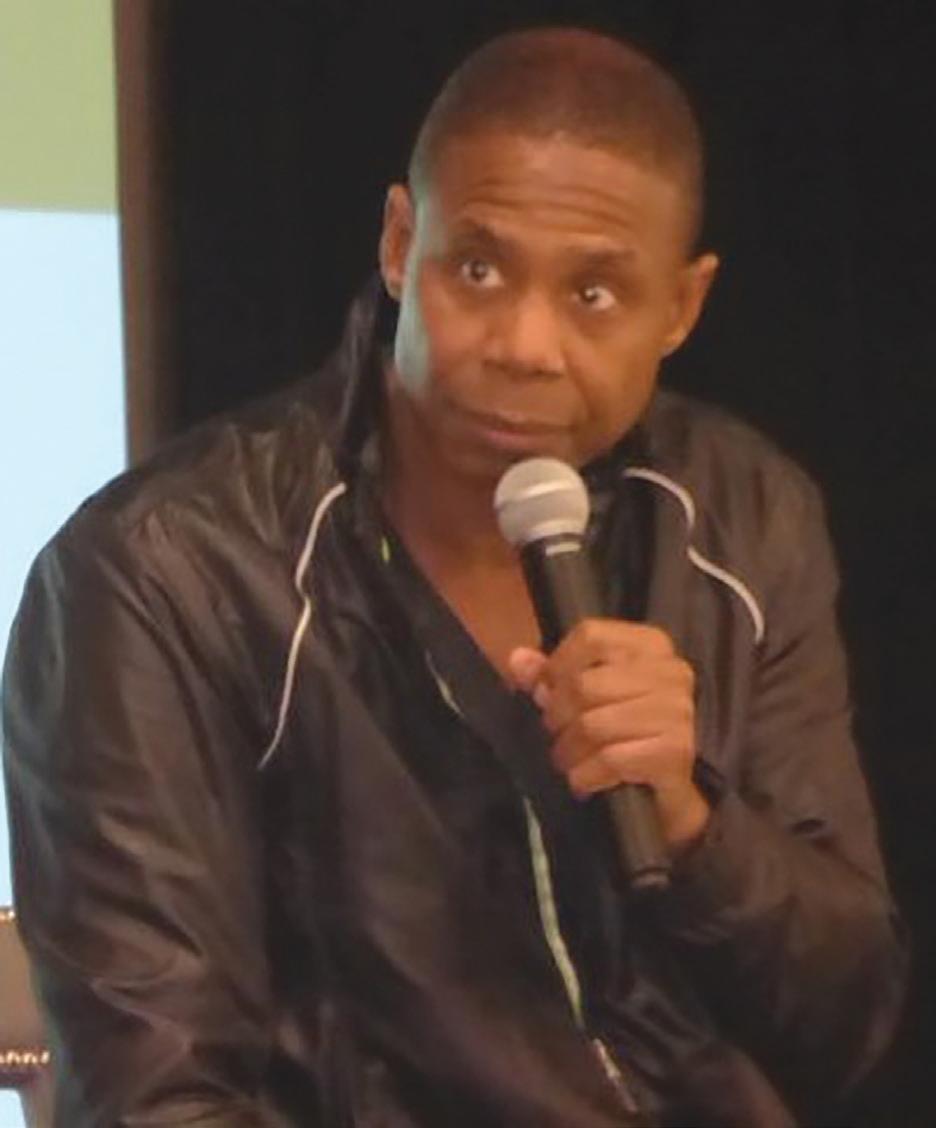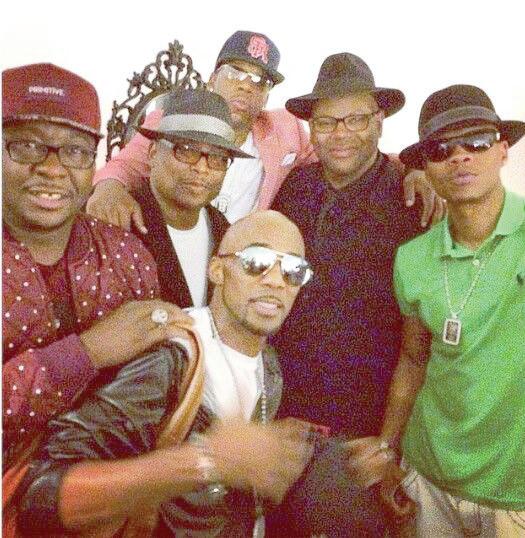

New Edition Announces Las Vegas Residency Dates
Los Angeles Los Angeles
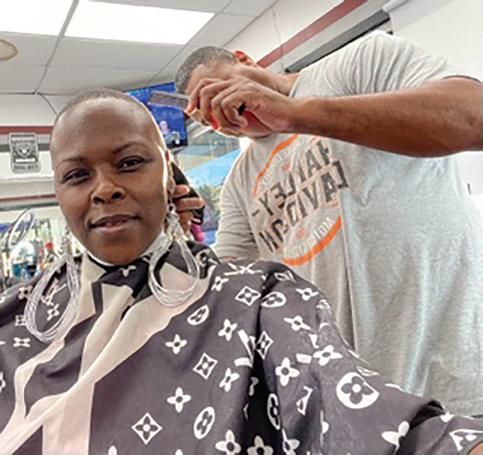

Pasadena Businessman and News Publisher Joe C. Hopkins Remembered for His Courage and Leadership
Solomon O. Smith
California Black Media
Last week, the Pasadena community lost a towering symbol of leadership and courage, Joe C. Hopkins. A lawyer, activist, publisher, husband and father, Hopkins passed away on Oct. 31 after decades of dedicated service to the community. Hopkins was a prominent presence in “Dena,” the local nickname for the Pasadena/Altadena area. A resident
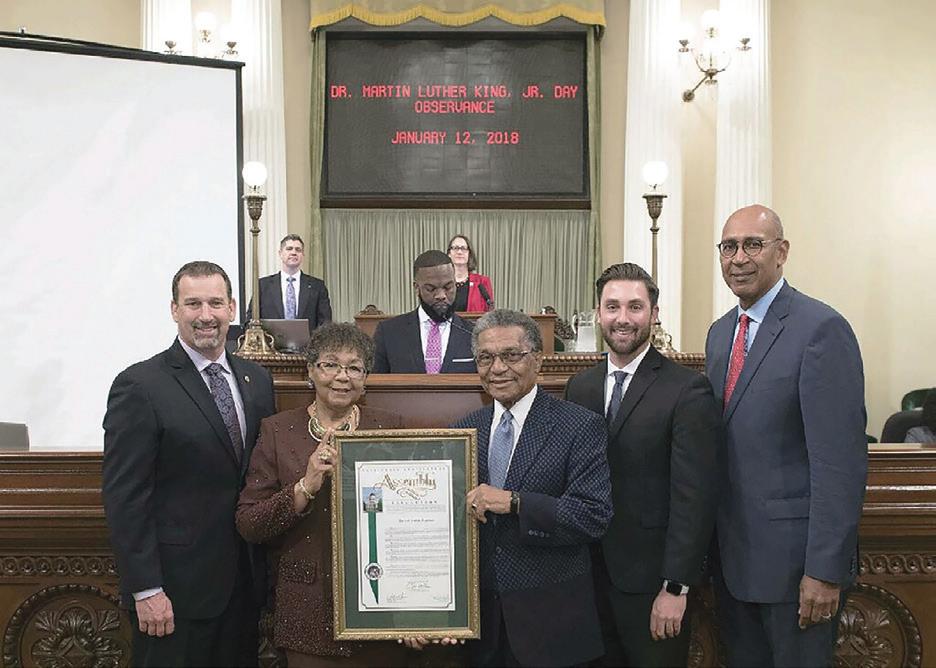
Assemblymember Chris Holden honors Joe and Ruthie Hopkins at the state capitol for the MLK celebration on January 12, 2018, Asm. Brian Dhale, Asm. Ian Calderon.
for over 40 years, Hopkins, and his wife Ruthie, are deeply embedded in their local community, establishing meaningful relationships with people from diverse backgrounds. Their influence extended beyond Pasadena, inspiring and shaping California’s Black political and social circles in numerous ways.
Hopkins was born in Altus, Oklahoma. He relocated to California in 1967, settling in Altadena in 1969. He earned his Juris Doctorate from Glendale University College of Law and in 1982 he began his legal practice which he later moved to Pasadena in 1986.
Hopkins was a man of conviction who fearlessly defended what he believed in. It was his strength of character and clarity of perspective that made him an effective leader.
Hopkins once held the position of president of
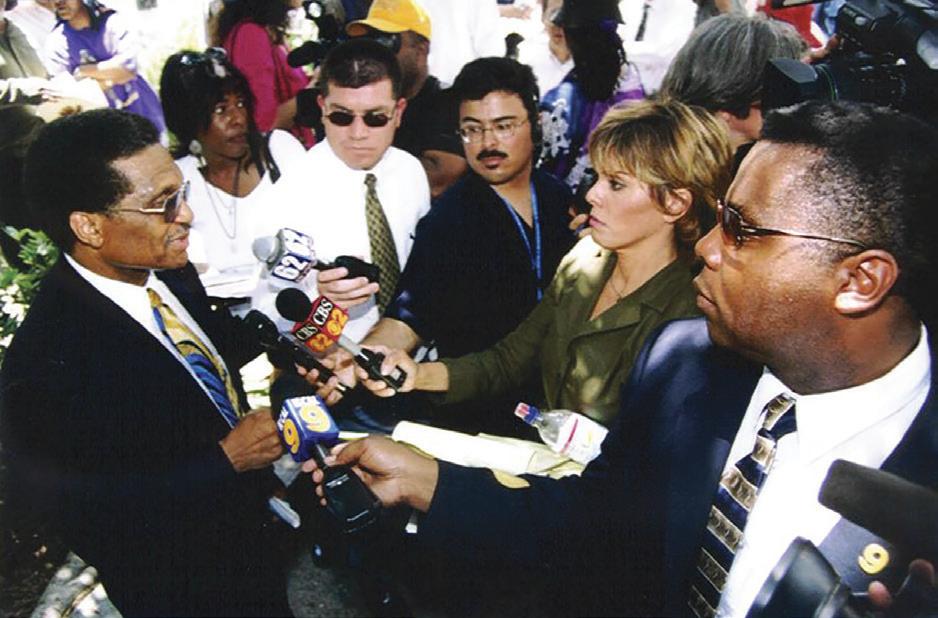
Congresswoman
the West Coast Black Publishers Association and was the president emeritus of the San Gabriel Valley Black Business Association. He founded the Pasadena/Altadena Black Lawyers Association and headed the Pasadena Black Expo from 1990-1992. He started the Pasadena/Altadena Journal, the first and only Black publication in “the Valley,” a region located north of Los Angeles that spans several other San Fernando Valley cities, including Burbank, Studio City, Glendale and Sherman Oaks.
Hopkins’ accomplishments have been acknowledged numerous times: He received the Appreciation for Outstanding Contributions in Business from the Altadena NAACP Branch in 1990, the Citizen of the Year Award from Omega Psi Phi Fraternity in 1992 and served as the Community Grand Marshall of the Pasadena Black History Parade in 2000. In 2006, he was awarded a Certificate of Special Congressional Recognition from Congressman Adam B. Schiff (D-CA-30). Additionally, he has been honored with numerous special recognitions from various city, state and national organizations. In 2018, Hopkins and his wife were honored as civil rights pioneers and “Unsung Heroes” by the California Legislative Black Caucus (CLBC). The award was presented by Assemblymember Chris Holden (D-Pasadena).
In a statement following Hopkins’ passing, Holden said, “My life and the lives of many other people are forever changed by the impact of Joe Hopkins and his wife Ruthie. I will miss Joe’s fearless leadership and unrelenting dedication to community.”
Hopkins’ personal achievements were substantial, and their enduring impact makes his loss deeply felt by the greater Pasadena community.
Sen. Anthony Portantino (D-Burbank) recalls being inspired by Hopkins’ writing in his book, “I will not Apologize,” a collection of his opinion pieces many consider to be the core of his beliefs.
After reading his book Portantino had to meet the man behind the “no nonsense” words. Hopkins was not easily impressed and quizzed Portantino about whether he read his book. They bonded over that conversation and their mutual desire to create a bridge between higher education in California and Historically Black Colleges and Universities (HBCUs). Together, they encouraged leaders and educators from UCLA to establish the Summer Institute for Emerging Managers and Leaders in 2012. The program’s purpose is to “increase the diversity of graduate students enrolled in the UC business schools.
The program continues to diversify leadership in California graduate schools.
“We connected on a friendship level and continued to talk policy and as the world changed, we kept talking to each other,” said Portantino. “The community has lost a special person, a great dad and a tremendous leader.”
Condolences have been extended to the family from the mayor of Pasadena, Victor Gordo, and other community leaders offering comfort during their time of bereavement.
Hopkins’ son, Yusef Olaitan-Hopkins, remembers his father as more than a political leader, entrepreneur or civil rights leader. He cherishes intimate memories of his father as a caring parent, selflessly dedicated to his family and community. According to Olaitan-Hopkins, the family is overwhelmed by the community’s expression of sympathy.
Hopkins, according to his son, was always ready to defend others with his knowledge of the law, leadership or his presence.
“One of the things my dad used to say was ‘find a good fight and get into it’,” said Yusef. “He was going to do this on his own terms.”
Hopkins’ legacy extends beyond the publications, books, and organizations he started and led. It endures
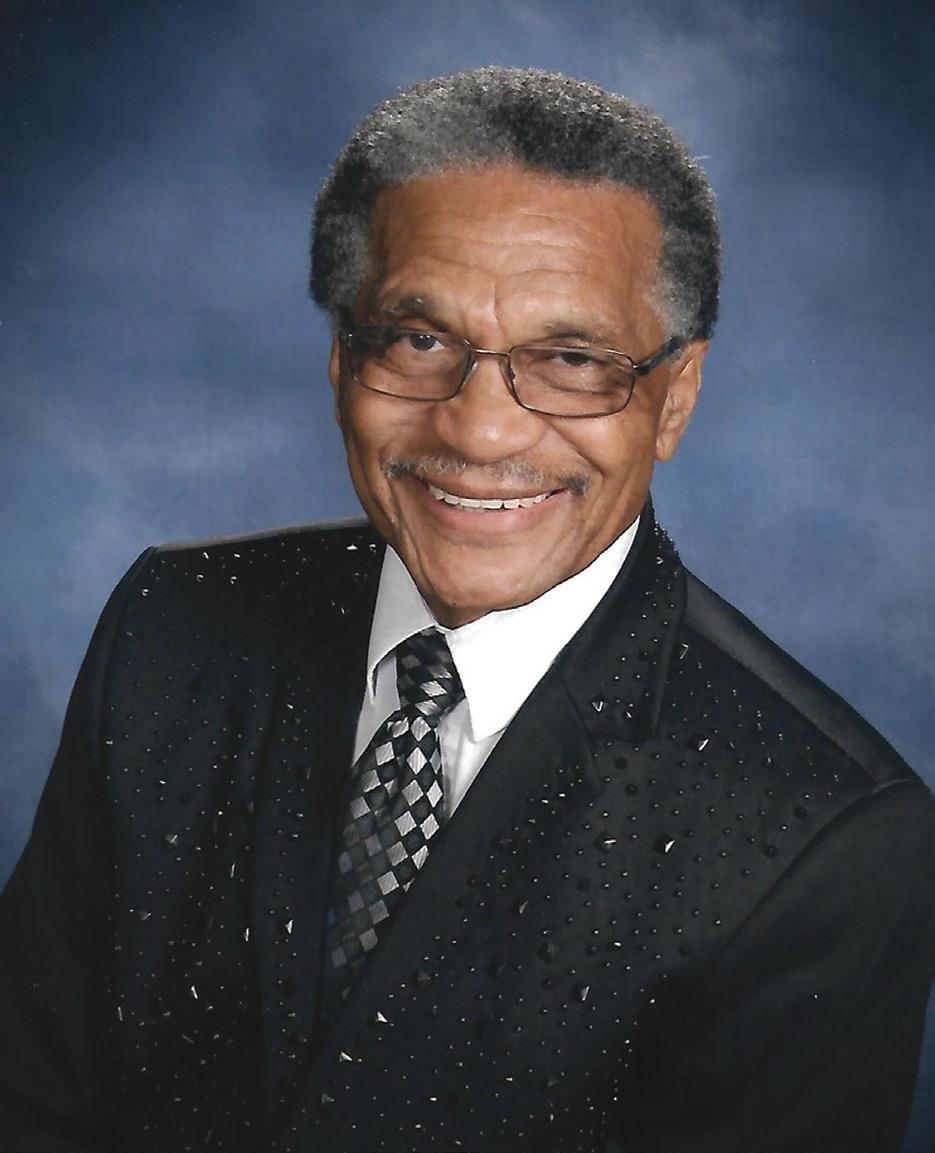
through the loving family he leaves behind, including his granddaughter Ife Olaitan, a social worker, therapist and the mother of his only great-grandchild. For Olaitan it was a privilege to grow up knowing her grandfather and having him get to know his great-granddaughter. She recalls how her grandparents inspired her to follow her own path and do “what’s right,” something she is passing down to her child.
“He was always on the side of fighting for what was right and what was just,” said Olaitan. “He was a man with a stance, and he loved a good fight.” Hopkins is survived by his wife Ruthie, three sons: Yusef, Omar, and Jamal, as well as seven grandchildren and one great-grandchild. Messages of condolence to the Hopkins family can be sent to pasadenajournalweb@gmail.com.
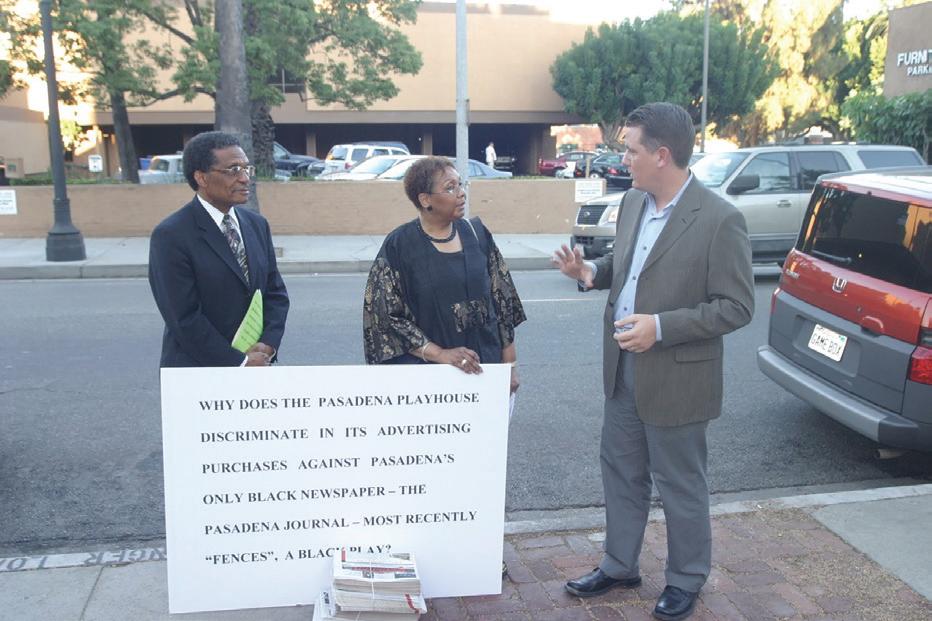
Supports
in New York and was raised there and in Baltimore, but he moved with his mother to the San Francisco Bay Area in the late 1980s. He would live in Oakland in the early 1990s and embraced it as an adopted hometown.
“He claimed Oakland,” said City Councilwoman Carroll Fife, who led the effort to rename the street. “He said Oakland gave him his game.” The ceremony came the day after a former Southern California street gang leader pleaded not guilty to murder in the Las Vegas shooting death of Shakur. Shakur`s relatives have kept their distance from the prosecution and made only passing reference to it Friday. Sekyiwa Shakur said her brother “died at 25 years old in gang violence, by the hands of another Black man, by the planning of another Black man, whoever that man may be.” Former Detroit-Area
Officer Indicted on Civil Rights Crime for Punching Black Man
WARREN, Mich. (AP) –– A grand jury returned an indictment against a former suburban Detroit police officer who is accused of a federal civil rights crime for punching a young Black man in the face and slamming his head to the ground. The two-count indictment
fired on June 23 and charged with two misdemeanors in state court. Besides the civil rights crime, Rodriguez faces a federal charge of falsifying records about the incident. A message seeking comment from his attorney wasn`t immediately returned Friday. “The conduct that is alleged here, a blatant and shocking violation
equity commitments following the murder of George Floyd, the diversity and inclusion of women and people of color working at investment firms did not increase substantially between 2019 and 2020, this includes the general workforce, executive level leadership, and board diversity. Here are just a few examples of the work she’s been
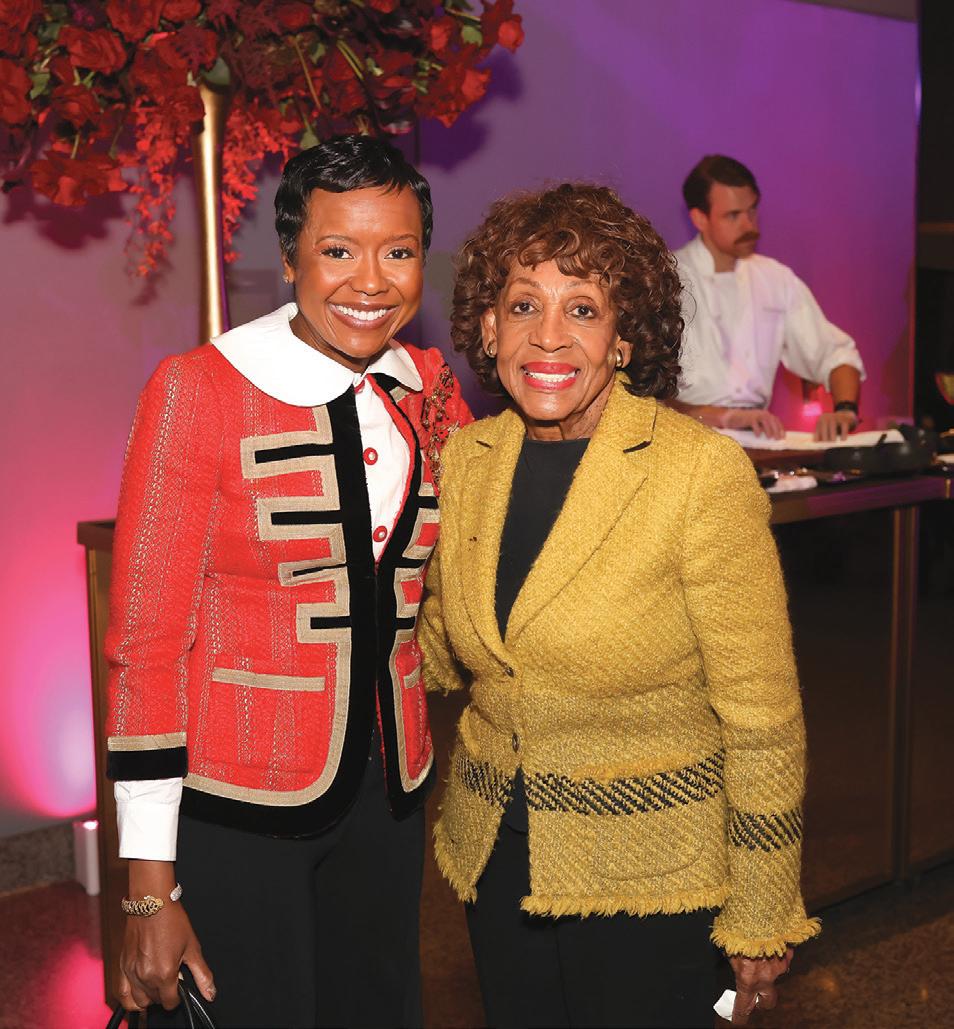
doing to
“If it was an open call, and Wesley was chosen, it would be fine. But because the process wasn’t open, that’s the big issue.” Wofford ultimately dropped out, and the city’s Office of Arts, Culture and the Creative Economy, known as Creative Philly, issued an open call in August 2022 that attracted dozens of submissions. After the finalists were chosen, the public got a chance to weigh in. City officials and the city’s African American Statue Advisory Committee, which included members of Tubman’s family, made the final selection. The $500,000 project budget includes artist payment, site work and modeling, engineering, materials and fabrication costs. The money comes from the city’s operating budget. The project is scheduled to be completed in 2025.
Biden Faces Eroding Support Among Arab, Muslim, and Black Americans, all Crucial Demographic Groups
By Stacy M. BrownNNPA
Newswire Senior National CorrespondentRepresentatives Rashida Tlaib (D-Michigan) and Dean Phillips (D-Minnesota) have reportedly emerged as formidable critics of President Joe Biden’s bid for reelection, publicly displaying a split within the party as Democrats desperately attempt to hold onto the White House in 2024. Despite their ideological differences, the two lawmakers have independently voiced concerns about Biden’s policies, creating a unique challenge for the incumbent.
Tlaib, known for her progressive stance on issues, has sharply criticized Biden for his unwavering support of Israel, going so far as to accuse him of enabling the “genocide” of Palestinians in a video statement. As a Palestinian American, Tlaib’s stance could potentially sway Muslim and Arab American voters, a crucial demographic in swing states like Michigan, which is Tlaib’s home state.
Phillips, hailing from the centrist wing of the Democratic Party, has taken a further step by launching a primary challenge against Biden in New Hampshire. Advocating for generational change, Phillips has expressed doubt about Biden’s ability to defeat former President Donald Trump. He has also pledged to address economic concerns, vowing to “make America affordable again.”
The convergence of Tlaib and Phillips’ criticism of Biden is not entirely coincidental. Both represent various facets of the Democratic Party’s post-Trump landscape: Tlaib stands for the radical progressive movement through her association with the Squad. Phillips is a member of the Problem Solvers Caucus, which promotes nonpartisan solutions. Politico noted that both factions gained prominence during the Trump era, propelling Tlaib and Phillips to Congress in the 2018 elections. They later joined forces with Biden in the successful effort to unseat Trump in 2020. The fact that they are now voicing their discontent with Biden signals that the president may face
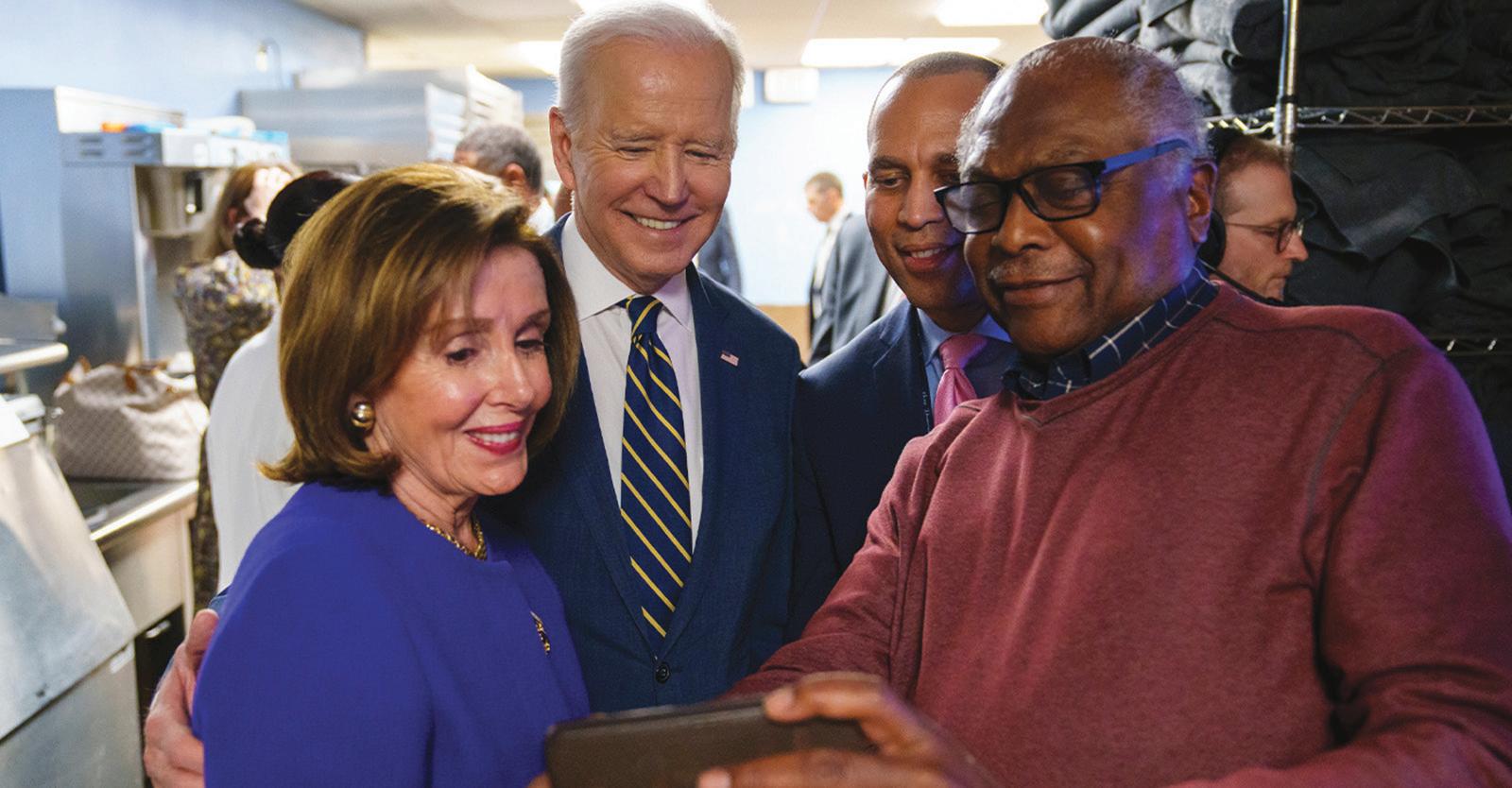
internal challenges within his party.
Recent polling data from The New York Times and Siena College indicates that Biden is trailing the twiceimpeached former President Trump in five of the six crucial battleground states, just one year before the 2024 election. Concerns about Biden’s age – even though Trump is just three years younger – and dissatisfaction with his handling of the economy contribute to this decline in support. On
average, Biden is trailing Trump by 48 to 44 percent across these states, all of which he won in 2020. And that’s despite Trump’s myriad of legal problems, which include facing 91 felony charges, having been found responsible for sexually assaulting a writer, and having a judge declare that he committed business fraud.
The most recent poll also highlights a growing discontent among voters, with a majority feeling that Biden’s
policies have personally harmed them. Additionally, the multiracial and multigenerational coalition that supported Biden in 2020 is showing signs of strain, as demographic groups that once strongly favored him are now more evenly split.
Among voters under 30, Biden’s lead is marginal, and his support among Hispanic voters has significantly dwindled. In urban areas, Biden’s advantage is now half of Trump’s lead in rural regions. Notably, male voters are now favoring Trump by a significant margin, reversing a genderbased advantage that Democrats had previously enjoyed. Even traditionally strong Democratic demographics, such as Black voters, are showing increased support for Trump, reportedly reaching 22 percent in some states. Biden’s handling of the Israel-Hamas conflict has also generated controversy, particularly among Arab American voters, with support for the president dropping from a comfortable majority in 2020 to just 17 percent.
The Arab American Institute recently commissioned a poll that further revealed that the majority of Arab Americans no longer identify as Democrats, with 32% siding with Republicans and 31% as independents. The poll also shows an uptick in support for Trump, who is likely to be the Republican candidate in 2024, with 40 percent indicating they would vote for him, a 5-point increase from 2020.
Politico and Axios have offered insight into the dynamics shaping the 2024 election. Politico’s analysis underscored the pivotal roles of Tlaib and Phillips. At the same time, Axios provided context regarding the ambitions of prominent Democratic figures like California Governor Gavin Newsom and Illinois Governor J.B. Pritzker in the lead-up to the 2028 presidential race and their ignorance of Biden’s 2024 re-election efforts.
New Polling Shows RFK Jr. Leading Biden and Trump Among Younger Voters in
Key Swing States
Los Angeles
twist in the
News Observer
Adjudicated a Newspaper of General Circulation on July 2, 1991, Los Angeles Superior Court Decree, Case No. BS007262, Government Code 6023.
Bulk Mailing Permit 724 Bakersfield, CA 93385
Published every Thursday by The Observer Group Newspapers of Southern California, Inc.
Member: National Newspaper Publishers Assc. Associated Press, Better Business Bureau, GLAAACC
President: Ellen Coley
CEO: Jon Coley
Publisher/ Editor: James Luckey Jr.
Operations Manager: James Luckey
Intern: William Clark Coley
Credo - The Black Press believes that America can best lead the world away from racial and national antagonisms when it accounts to every person, regardless of race, color, or creed full human and legal rights. Hating no person, fearing no person, the Black Press strives to help every person in the firm belief that all are hurt as long as any one is held back.
The Observer Group Newspapers reserves the right to publish views and opinions that may not necessarily reflect those of the staff and management are soleley the product of the responsible individuals who submit commentaries published in these newspapers. Letters, articles and comments appearing in the Observer Newspapers reflect the opinions of the contributor and do not constitute the opinion or endorsement by The Observer Newspapers or its staff. The Observer Group Newspapers assumes no responsibility for photographs, articles, letters, press releases and unsolicited materials. Decisions as to the editiing and publishing of materials are at the discretion of the Publisher and Editors. All rights are reserved on materials accepted for publication unless otherwise specified.
The Observer Group Newspapers of Southern California, Inc.:
2024 presidential campaign also signals real concerns with Biden’s age, but younger voters are also concerned with Trump, who is just three years younger than the incumbent president.
The poll, which The New York Times and Siena College conducted, revealed that in a hypothetical oneon-one contest, Trump would prevail over his predecessor in five of the crucial battleground states crucial to Biden’s victory in 2020. Notably, the survey underscored a notable shift in support among younger voters, with Kennedy emerging as a compelling independent challenger.
Across the swing states of Georgia, Arizona, Michigan, Pennsylvania, Nevada, and Wisconsin, Kennedy commands a 34 percent support base among 18 to 29-year-old voters, with an additional 31 percent among those aged 30 to 44. Trump’s figures stand at 29 percent and 30 percent, respectively, while Biden maintains 30 percent across both demographics.
Kennedy declared in September that he would run as an independent.
The 69-year-old child of Camelot, who initially contended for the Democratic nomination, has a political platform that encompasses a steadfast commitment to rectifying environmental disparities, dismantling qualified immunity in law enforcement, and addressing the deepseated racial inequities embedded within the American healthcare system.
Born in the District of Columbia, Kennedy’s dedication to redressing longstanding issues in marginalized communities is palpable. He said he envisions dismantling
systemic barriers and forging a more inclusive and equitable future, particularly for African Americans who have borne the weight of longstanding injustices, including the pressing issue of maternal mortality.
In the shadow of a storied political legacy, with his uncle John F. Kennedy revered as a highly respected president and his father’s Democratic nomination tragically cut short by an assassin’s bullet in 1968, Kennedy has embarked on a bold endeavor to challenge the current political paradigm and potentially catalyze a nationwide movement for change.
“Empowering Black Americans will be a central focus for me, especially in eradicating the pervasive fear of perilous encounters with law enforcement,” Kennedy emphasized during an interview with the Black Press of America.
He pledged to end qualified immunity, a legal protection shielding police officers from personal liability in legal proceedings. “Incentives for reform are lacking under the current system,” he asserted. “We must eliminate qualified immunity, compelling individuals to weigh their accountability in every interaction. A robust economic system should incentivize virtuous conduct and penalize transgressions. That’s what we need,” Kennedy emphasized.
Kennedy stressed the imperative of reshaping law enforcement’s perspective to one focused on safeguarding and serving communities rather than adopting a combative stance when entering Black neighborhoods. “We need systemic changes,” Kennedy insisted.
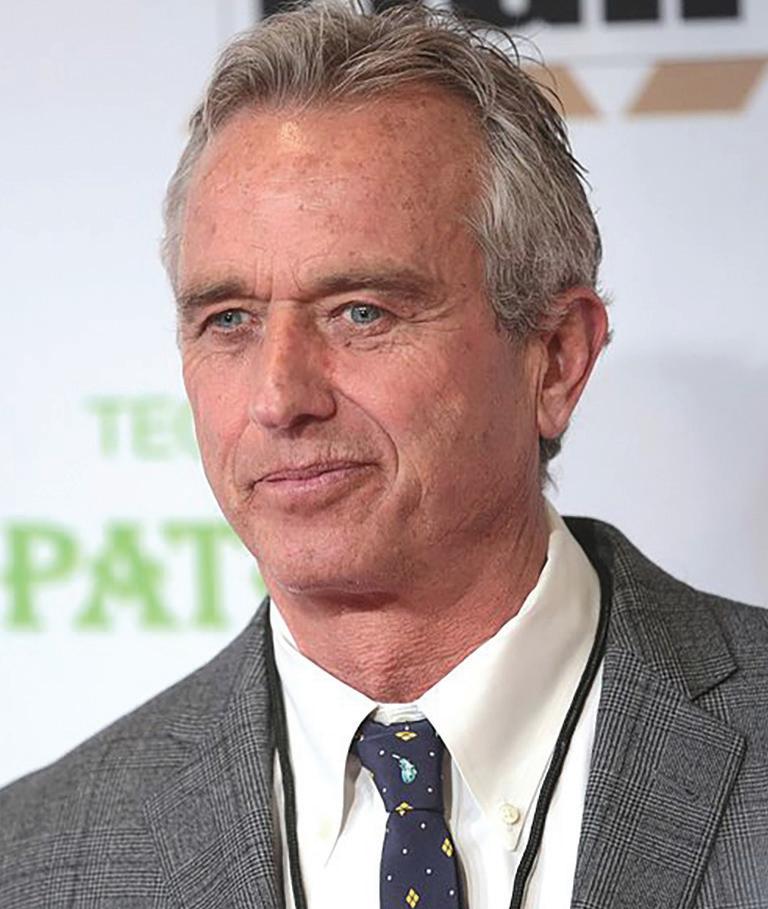
Pro-Palestinian Demonstrations Sweep Across Global Cities
By Stacy M. Brown NNPA Newswire Senior National CorrespondentTens of thousands of pro-Palestinian demonstrators took to the streets on Saturday, marching from Washington to Milan to Paris, demanding an end to Israel’s bombardment of Gaza. The protests highlighted growing concern over the rising civilian death toll and suffering resulting from the Israel-Hamas conflict. Protesters in countries with substantial Muslim populations, including the U.S., U.K., and France, expressed disillusionment with their governments for their support of Israel amidst intensifying attacks on hospitals and residential areas in the Gaza Strip. According to the Hamas-run Health Ministry in Gaza, the Palestinian death toll in the Israel-Hamas war has now reached 9,448. In Israel, over 1,400 people have lost their lives, with most casualties occurring during the October 7 Hamas attack that ignited the conflict. In Washington, D.C., thousands gathered at the nation’s capital to protest the Biden administration’s stance on Israel and its ongoing military campaign in Gaza. Chants of “Palestine will be free” filled
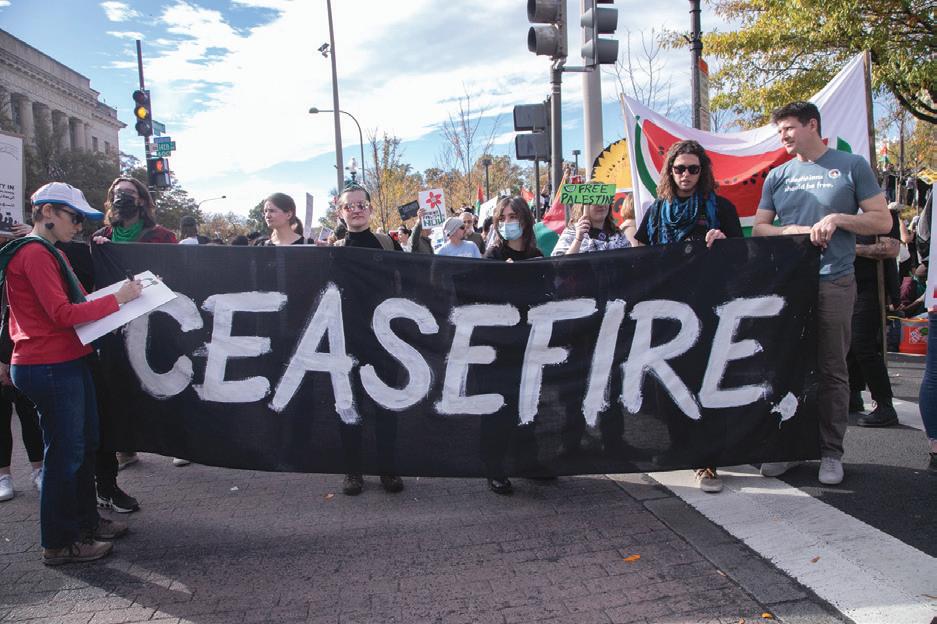
U.S., U.K., and France, expressed disillusionment with their governments for their support of Israel amidst intensifying attacks on hospitals and residential areas in the Gaza Strip.
Pennsylvania Avenue, leading up to the White House, as a massive Palestinian flag was unfurled. Simultaneously, demonstrations took place in New York, London, and Paris, echoing the sentiments of the protest in Washington. Many speakers at the rallies focused
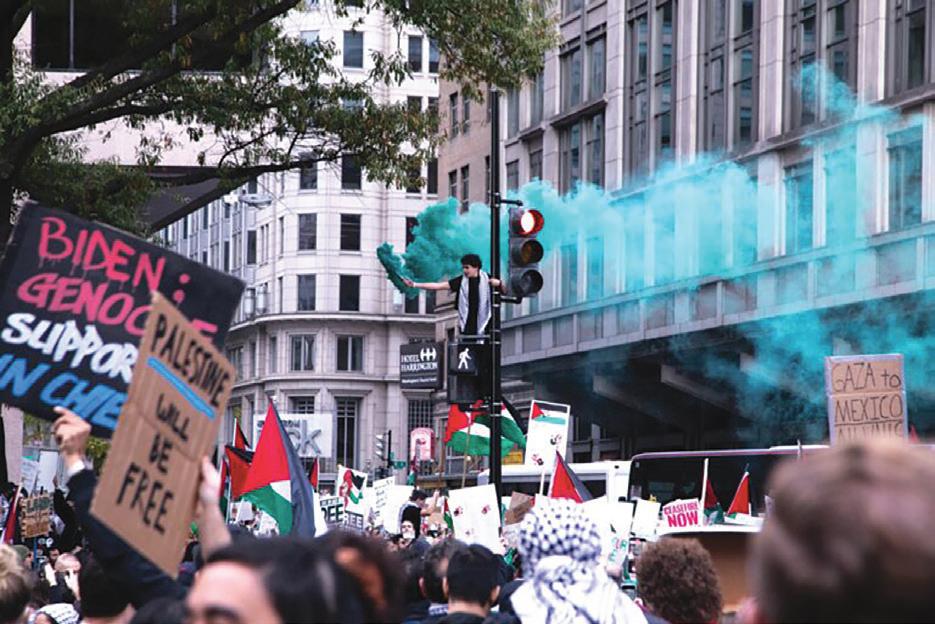
on President Biden’s support for Israel’s war efforts and his opposition to a cease-fire. One member of the U.S. Campaign for Palestinian Rights referred to the president as “Genocide Joe.” Later, images circulated online of scores of demonstrators marching towards the United Nations building in Midtown Manhattan. The New York City Police Department reported temporary road closures due to the protest, but no arrests had been made. Mayor Eric Adams said he was monitoring the situation. As of Saturday evening, U.N. press officers had yet to respond to emails seeking comment. On Friday, the San Francisco Chronicle reported that protesters at the Port of Oakland in California had climbed aboard a U.S. military vessel believed to be en route to Israel. In Europe, at least 11 individuals were arrested in London on Saturday afternoon as a surge of hundreds of demonstrators brought the Oxford Circus shopping and tourist district to a standstill. Streets were blocked, and slogans in support of the Palestinian people were chanted. Israeli Prime Minister Benjamin Netanyahu
rejected pleas by President Biden and Secretary of State Antony Blinken for a “humanitarian pause” in the fighting that would allow for the delivery of food and medical supplies to Gaza.
Following a meeting with Blinken in Tel Aviv, Netanyahu stated, “I have made it clear that we are continuing forcefully, and that Israel refuses a temporary cease-fire that does not include the release of our hostages. Israel does not allow the entry of fuel to the Gaza Strip and opposes the transfer of funds to Gaza.” According to data from the Hamas-run Gaza health ministry, Israeli airstrikes have killed 9,257 people in the coastal enclave since October 7, including 3,826 children, according to a U.N. report on Friday. Less than one-third of Gaza’s hospitals are currently operational, and the territory has only seven days’ worth of food stocks remaining, according to the U.N. Secretary of State Antony Blinken emphasized, “We stand strongly with and behind Israel in its right and obligation to defend itself, defend its people, and take the steps necessary to try to ensure that this never happens again.” He also underscored “the imperative of doing everything possible to protect civilians, the imperative of doing everything possible to get assistance to those who need it.”
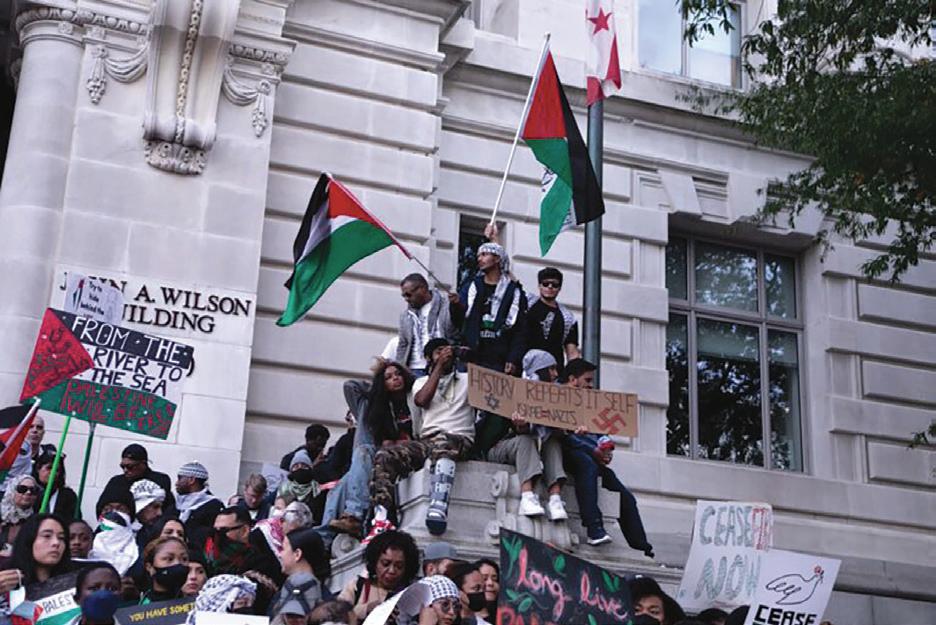
After Touring for 2 Years
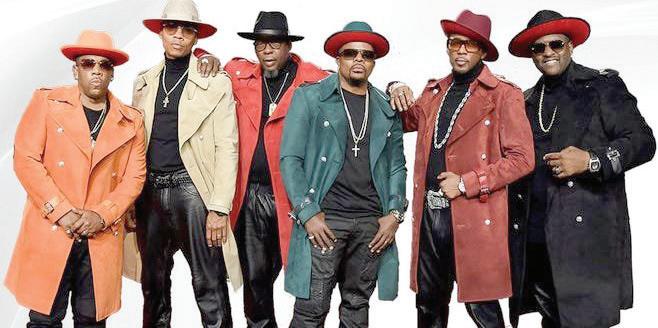
New Edition Announces Las Vegas Residency Dates Starting in Late February
By JONATHAN LANDRUM Jr. AP Entertainment WriterLOS ANGELES (AP) –– R&B group New Edition will bring their New Jack Swing tunes to Las Vegas early next year. The Grammy-nominated sextet announced Monday that New Edition: Las Vegas will kick off Feb. 28. The group confirmed six residency shows at the Wynn Las Vegas' Encore Theater, where acts like Diana Ross, Duran Duran, Lionel Richie and Brad Paisley have taken the stage. "We just caught lightning in a bottle," said Ronnie DeVoe, a founding member of New Edition __ which includes Michael Bivins, Bobby Brown, Johnny Gill, Ralph Tresvant and Ricky Bell. Monday`s announcement came after days after the group performed a tightly choreographed tribute to the Spinners at the Rock & Roll Hall of Fame induction ceremony in New York.
DeVoe said the band heard fans countless requests __ particularly through social media __ for them to perform in Sin City. "We`re looking to touch that stage and continue on with the legacy," he said. After two consecutive North American tours, New Edition has planned for a more intimate setting at Encore, which seats 1,480. "This is going to more theatrical than our Legacy and Culture tours," Brown said. "This will be a lot more intimate. We wanted it to be up, close and personal for our fans."
New Edition was founded by childhood friends in a Boston housing project and became one of the originators of the modern-day boy band. The group released their debut album "Candy Girl" in 1983 and rejuvenated the teen music scene in the mold of The Jackson Five with hit singles like "Candy Girl," "Mr. Telephone Man" and
"Cool It Now."
The group maintained success after puberty and laid the foundation for groups such as New Kids on the Block, the Backstreet Boys and Boyz II Men.
But then, New Edition faced plenty of conflict __ which included Brown's erratic behavior during a concert tour, resulting in him being kicked out the group. Tensions grew after Brown was replaced by Gill.
Brown found success as a solo artist with the 1988 hit "Don't Be Cruel." Gill and Tresvant had their own solo careers, while Bell, Bivins and DeVoe created their own group, Bell Biv DeVoe, and soared with their 1990 debut album, "Poison, " which went quadruple platinum.
But eventually, all six members reconciled, reuniting for their sixth studio album "Home Again" in 1996. The group has toured the past couple of years.
Bell said the tours helped build cohesiveness and
created more of an opportunity to appreciate each other. He`s grateful for the group`s longevity: "We have each other, we have our health, we have our families. Everybody's still here.``
Bivins said the same authentic brotherhood shown during New Edition's recent tours will be on display in Las Vegas. "Our audience got a chance to see growth, bond, brotherhood,`` he said. ``Sometimes that's bigger than any record because people come to look for separation. But I think we'll give them the glue."
New Edition hasn`t released an album since 2004, but DeVoe said there`s a good chance the group will release new music leading up to their residency stint.
"It makes sense,`` he said. "I think it`ll be a great time to get in the studio and put our vocals on something new and fresh."
Ex-Gang Leader Pleads Not Guilty in 1996 Tupac Shakur Killing in Vegas
By KEN RITTER Associated PressLAS VEGAS (AP) –– A former Southern California street gang leader pleaded not guilty Thursday to murder in the 1996 killing of rap music icon Tupac Shakur in Las Vegas __ a charge prompted by his own descriptions in recent years about orchestrating the deadly drive-by shooting.
Duane Keith "Keffe D" Davis is the only person still alive who was in the vehicle from which shots were fired and the only person ever charged with a crime in the case. In court on Thursday, Davis stood in shackles as he awaited proceedings and waved to his wife, son and daughter in the packed spectator gallery.
"Not guilty," Davis said when Clark County District Court Judge Tierra Jones asked for his plea.
The judge told Davis that prosecutors are not seeking the death penalty in the case, which could put Davis in prison for the rest of his life if he is convicted. Jones also named county special public defenders Robert Arroyo and Charles Cano to represent Davis at taxpayer expense, after Davis lost his bid to hire private defense attorney Ross Goodman. Goodman two weeks ago said prosecutors lack
witnesses and key evidence, including a gun or vehicle, for the killing committed 27 years ago. Outside the courtroom on Thursday, Goodman said Davis was still trying to hire him. Davis` family members declined to comment.
Clark County District Attorney Steve Wolfson told reporters that he and a panel of prosecutors decided the case against Davis was "not the kind of case that should proceed with the asking of the death penalty." He didn`t specify reasons for that decision.
Wolfson also declined to respond to Goodman`s criticism of the evidence, saying that a jury will weigh the results of the police investigation.
In court, Davis wore dark-blue jail garb and answered several questions, telling the judge that he attended "a year in college," wasn`t under the influence of drugs, medication or alcohol, and he understood he is charged with murder. The judge set his next court date for Tuesday to schedule the trial.
Davis, 60, is originally from Compton, California.
He was arrested Sept. 29 outside a home in suburban Henderson where Las Vegas police served a search warrant July 17, drawing renewed attention to one of hip-hop music's most enduring mysteries. Davis remains jailed without bail, did not testify before the grand jury that
indicted him, and declined from jail to speak with The Associated Press.
The indictment alleges Davis obtained and provided a gun to someone in the back seat of a Cadillac before the car-to-car gunfire that mortally wounded Shakur and wounded rap music mogul Marion "Suge" Knight at an intersection just off the Las Vegas Strip. Shakur died a week later. He was 25.
Knight, now 58, is in prison in California, serving a 28-year sentence for the death of a Compton businessman in 2015. He has not responded to messages through his attorneys seeking comment about Davis' arrest.
Prosecutors allege that Shakur`s killing in Las Vegas came out of competition between East Coast members of a Bloods gang sect and West Coast groups of a Crips sect, including Davis, for dominance in a musical genre dubbed "gangsta rap.``
The grand jury was told the Sept. 7, 1996 shooting in Las Vegas was retaliation for a brawl hours earlier at a Las Vegas Strip casino involving Shakur and Davis' nephew, Orlando "Baby Lane" Anderson.
Wallace, also known as Biggie Smalls, was shot and killed in Los Angeles in March 1997, six months after Shakur's death. Shakur is largely considered one of the most influential and versatile rappers of all time. He had five No. 1 albums, was nominated for six Grammy Awards, was inducted into the Rock & Roll Hall of Fame in 2017, and received a posthumous star this year on the Hollywood Walk of Fame.
Prosecutors told a grand jury that Davis implicated himself in the killing in multiple interviews and a 2019 tell-all memoir that described his life leading a Crips sect in Compton. Davis has said he obtained a .40-caliber handgun and handed it to Anderson, a member of Davis' gang, in the back seat of a Cadillac, though he didn't identify Anderson as the shooter. Anderson, then 22, denied involvement in Shakur's killing and died two years later in a shooting in his hometown of Compton. The other back seat passenger and the driver of the Cadillac are also dead. In his book, Davis wrote that he told authorities in 2010 what he knew of the killings of Shakur and gang rival Notorious B.I.G, whose legal name is Christopher Wallace, to protect himself and 48 of his Southside Compton Crips gang associates from prosecution and the possibility of life sentences in prison.
Missy Elliott, Willie Nelson, and Chaka
Khan ready for Rock & Roll Hall of Fame
By MARK KENNEDYCortes de California (www. sucorte.ca.gov), en la biblioteca de leyes de su condado o en la corte que le quede más cerca. Si no puede pagar la cuota de presentación, pida al secretario de la corte que le dé un formulario de exención de pago de cuotas. Si no presenta su respuesta a tiempo, puede perder el caso por incumplimiento y la corte le podrá quitar su sueldo, dinero y bienes sin más advertencia. Hay otros requisitos legales. Es recomendable que llame a un abogado inmediatamente. Si no conoce a un abogado, puede llamar a un servicio de remisión a abogados. Si no puede pagar a un abogado, es posible que cumpla con los requisitos para obtener servicios legales gratuitos de un programa de servicios legales
California Black Media Political Playback: News You Might Have Missed
California State University Faculty Vote to Authorize Strike
The California Faculty Association (CFA), the union representing faculty at California State University (CSU) schools has voted to authorize a strike if it cannot reach a deal with the 23-campus system’s administration. CFA represents approximately 29,000 professors, lecturers, coaches and other faculty across the state.
“Cal State voted overwhelmingly to authorize a strike, if necessary,” said Charles Toombs, a professor and former chairperson of Africana Studies at San Diego State University (SDSU) and the union’s president, during a virtual press conference Oct 30. “Members are emphatic that low pay, growing workloads, and systematic inequalities are not sustainable.
The union pushed for 12% across-the-board increases this fiscal year, but CSU offered 12% over the next three years. When CFA refused to consider a multi-year offer, the CSU offered a one-year GSI of 5%. CFA then declared an impasse within 40 minutes of receiving this offer.
“We are still moving through the statutory process. CFA members plan on bringing our demands and solidarity to trustees and new Chancellor Mildred García at the November 7 CSU Board of Trustees meeting in Long Beach,” read a press release from CFA.
“CSU management says they can’t afford our re-opener proposals, but a CFA fiscal analysis shows otherwise . The CSU has been hoarding billions of dollars in reserves instead of investing in faculty and staff who work directly with our students. Their investment in administrative personnel is increasing while their investment in instructional support continues to shrink,” it continued.
In the fall of 2022, 18,308 Black or African American students (4.0%) were enrolled in the CSU system. Overall, the CSU system. The CSU system is comprised of 23 universities with nearly 500,000 students.
PPIC Releases Report on Community College
Access
“Tracking Progress in Community College Access and Success,” a report by the Public Policy Institute of California (PPIC) examines the effects of Assembly Bill (AB) 705 authored by Jacqui Irwin (D-Thousand Oaks) and passed in 2017 that changed the assessment and placement practices for community college students in California.
AB 705 requires California community colleges to use multiple measures like high school coursework, grades, and GPA for student placement in transfer-level Math and English courses without needing to take remedial courses first. The law aims to ensure that students are starting and finishing the English and Math courses during their first year.
By replacing standardized tests used for Math and English course placement, AB 705 addressed criticisms of inaccuracies, inequities, and biases that disadvantaged some groups of students, especially Black, Latino, and English Language Learners.
The report shows both the progress students made from the fall of 2018 to fall 2022, and the challenges remaining to be addressed. While access and completion rates have improved substantially for all students, there are still large equity gaps between racial/ethnic groups, especially for Black students.
For example, in transfer-level math, the white-Black gap in one-term course completion is 22 percentage points, and the White-Latino gap is 17 points. In transfer-level English, the White-Black gap is 13 points, and the WhiteLatino gap is 10 points. Black students are also less likely to enroll in corequisite courses, which provide additional support and are taken concurrently with the transfer-level course and offer extra instruction, tutoring, or mentoring to help students succeed.
The report recommends several strategies and initiatives that can help improve outcomes and reduce disparities. They include the involvement and cooperation of institutions, efficient supports and resources for students, data-driven decision-making, and targeted programs for Black students.
Some examples of the targeted programs for Black students are:
Umoja Community: A statewide program that provides culturally relevant curriculum, mentoring, counseling, and academic support to increase the success and retention of Black students.
African American Male Education Network and Development (A2MEND): A program that focuses on
empowering Black male students through leadership development, personal growth, and academic achievement.
Puente Project: A program that aims to increase the number of educationally underserved students who enroll in four-year colleges and universities, earn degrees, and return to the community as leaders and mentors.
California Promise: A program that offers two years of free tuition to first-time, full-time students who meet certain eligibility criteria.
The report is based on data from the California Community Colleges Chancellor’s Office and interviews with faculty and administrators from selected colleges.
Asm. Mike Gipson Shares Legal Details About Closing of Lincoln Cemetery With Concerned Constituents
California Legislative Black Caucus member Assemblymember Mike Gipson (D-Carson) provided an update on the circumstances surrounding the closing of Lincoln Memorial Park, a cemetery located in Carson.
Outraged families of loved ones laid to rest at Lincoln Memorial Park have been under a cloud of frustration about the privately-owned cemetery. Gipson stated that the California Department of Consumer Affairs’ Cemetery and Funeral Bureau (CFB) has posted a Frequently Asked Questions FAQ document that updates the public on the status of Lincoln Cemetery.
“It has been just over two months since the cemetery license was canceled. CFB’s FAQ explains what this means in specific terms, from a legal perspective,” Gipson wrote.
The owner of the cemetery, Michael Mintz, abandoned the property and surrendered his cemetery license. The gates to the 20-acre property were briefly locked and it was reopened despite disrepair and neglect.
The cemetery holds historical significance dating back to the 1930s. Some of those interred were born after the Civil War. African American boxer Joe Lewis dedicated a plaque in Lincoln cemetery in 1949.
“I am continuing to explore all possible avenues that will expedite our path to license operations at the Lincoln Cemetery and I am advocating personally for our
California Launches Basic Income Program for Former Foster Children
Former foster youth living in the city and county of San Francisco are eligible to apply for a Guaranteed Income Pilot Program that will pay them $1200 a month for 18 months.
“Guaranteed income programs help level the playing field and will give these former foster youth the support and resources they need to pursue their California dream,” said Gov. Gavin Newsom in a statement when he announced the program Nov. 3. To support the program, the state awarded San Francisco $3,439,090. Another Guaranteed Income Pilot program will be launched in Ventura County with a $1,538,758 state investment.
“These pilots, through the Department of Social Services, will provide unconditional, individual, regular cash payments intended to disrupt poverty, advance equity, and support the basic needs of recipients,” said a press release from Newsom’s office.
San Franciscans who participate in the program will receive counseling and the state will measure the impact of the program on their lives and their eligibility for other public benefits.
“Transitioning out of the foster care system can be incredibly challenging for many of our youth, and this sustained unconditional income over 18 months will help systems-involved youth pursue their hopes and dreams. In doing so, our goal is to disrupt the cycle of poverty and advance a more equitable future for former foster youth,” said San Francisco Human Services Agency Deputy Director of Policy, Planning, and Public Affairs Susie Smith.
“This is an amazing opportunity to break the cycle of poverty experienced by many young adults transitioning out of foster care,” Smith added.
Unfadeable: The Power of Black Barbershops in Men’s Mental Health
Every week for 25 years, I have hit Our People Barbershop in Carson to see Tracy Prince for a fresh bald fade. As a Black woman entering a predominantly male space, I recognize Black barbershops as places of learning and community. Black men and boys, young and old, get exposed to ideas at the barbershop that teach them about who they are or hope to become. Like other shops throughout the country, there are passionate discussions about sports, politics, and issues impacting our communities and the world.
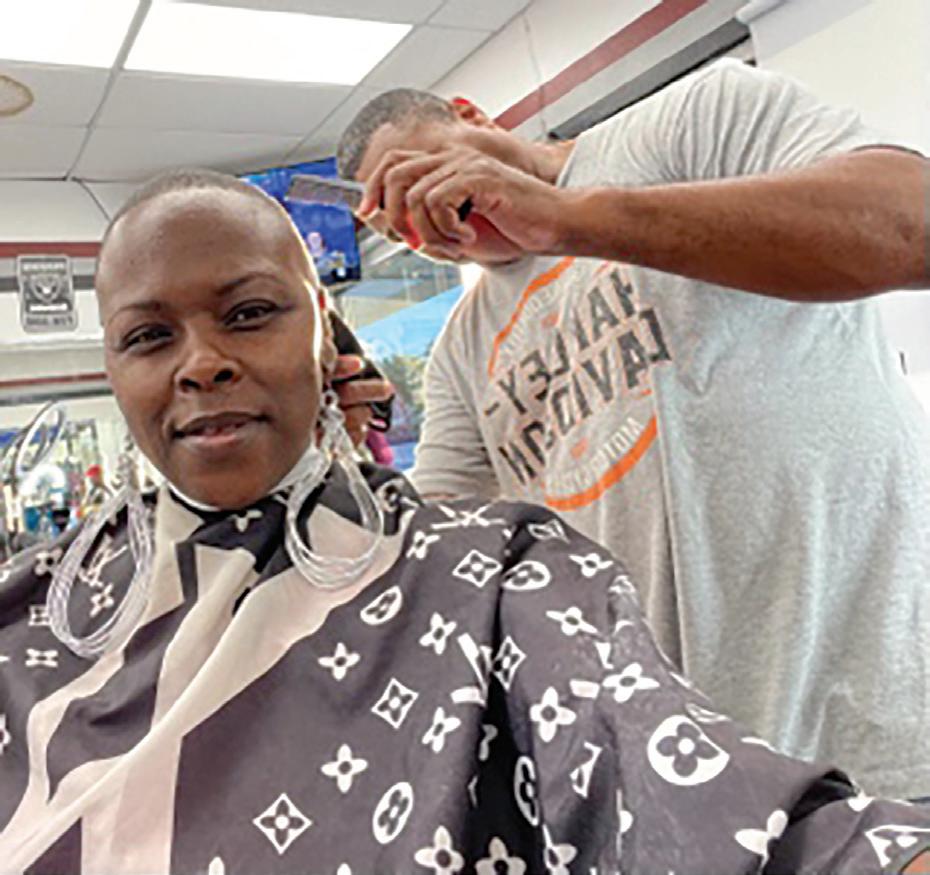
Despite the openness in these spaces, conversations about personal struggles, particularly mental health, remain scarce. Tracy says, “I see the fellas in here downplaying heartbreaks, making light of job losses, and masking their emotional pain, often dismissing their struggles with a simple, ‘It’s all good.’”
But it’s not. According to the CDC, suicide is the third leading cause of death for Black Americans ages 15 to 24, and Black men are four times more likely to take their own life than Black women. The State of Black Los Angeles reports that Black adults are more likely than white and Latino adults to experience persistent symptoms of depression. Couple these stats with undeniable biases against Black youth in education following them through an unjust justice system makes it a difficult time to be a Black male.
However, as mental health challenges continue to rise, so has increased awareness and opportunities for positive change. Organizations like Movember use November to highlight men’s health issues, including raising money to provide mental health support to men worldwide. In Los Angeles, the Black Emotion and Mental Health Collective (BEAM) illustrates a necessary shift toward holistic wellbeing in our communities. Through its Black Masculinity Reimagined, a community- and skills-building program, BEAM trains and supports Black men and masculine folks with addressing mental health and community violence.
A two-pronged empathetic approach is needed to continue addressing Black men’s mental health: acknowledging the problems and providing comprehensive solutions. First, we must foster inclusive communities, promote cultural competence in education, and dismantle systemic biases that have long plagued Black men and boys. We must also empower young Black men to express themselves without fear, shame, or judgment. Tracy believes, “If we bridge the gap between young brothas and the old heads, we could chop it up about everything – the good, the bad, the ugly, and the sad.”
Transforming our barbershops into cultural sanctuaries of mental health support for men fosters fellowship, empowers action, and opens dialogues about the issue. In doing so, we celebrate our culture and contribute to breaking the generational cycles of silence surrounding mental health, ensuring that Black men thrive in every aspect of their lives. I am here for it and my brothers.
To learn more about free behavioral health services offered to anyone through Planned Parenthood Los Angeles’ Black Health Initiative, visit https://www. plannedparenthood.org/planned-parenthood-los-angeles/ black-health-initiative.
Kara James, a Nurse Practitioner at Planned Parenthood Los Angeles since 2019, champions racial equity and antiracism in her clinical care. In 2020, she spearheaded the launch of the Black Health Initiative to enhance holistic well-being in Los Angeles’ Black communities.
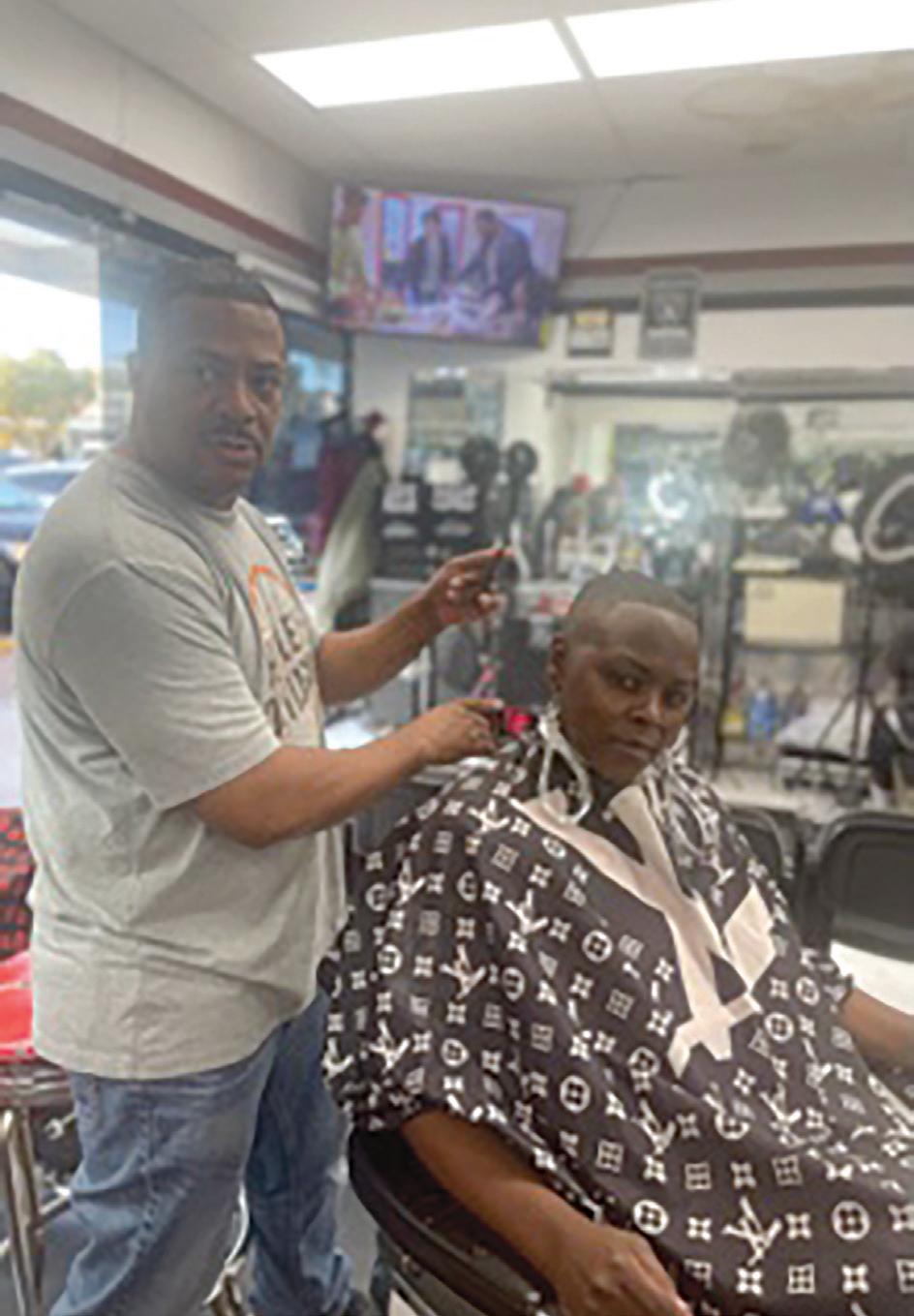
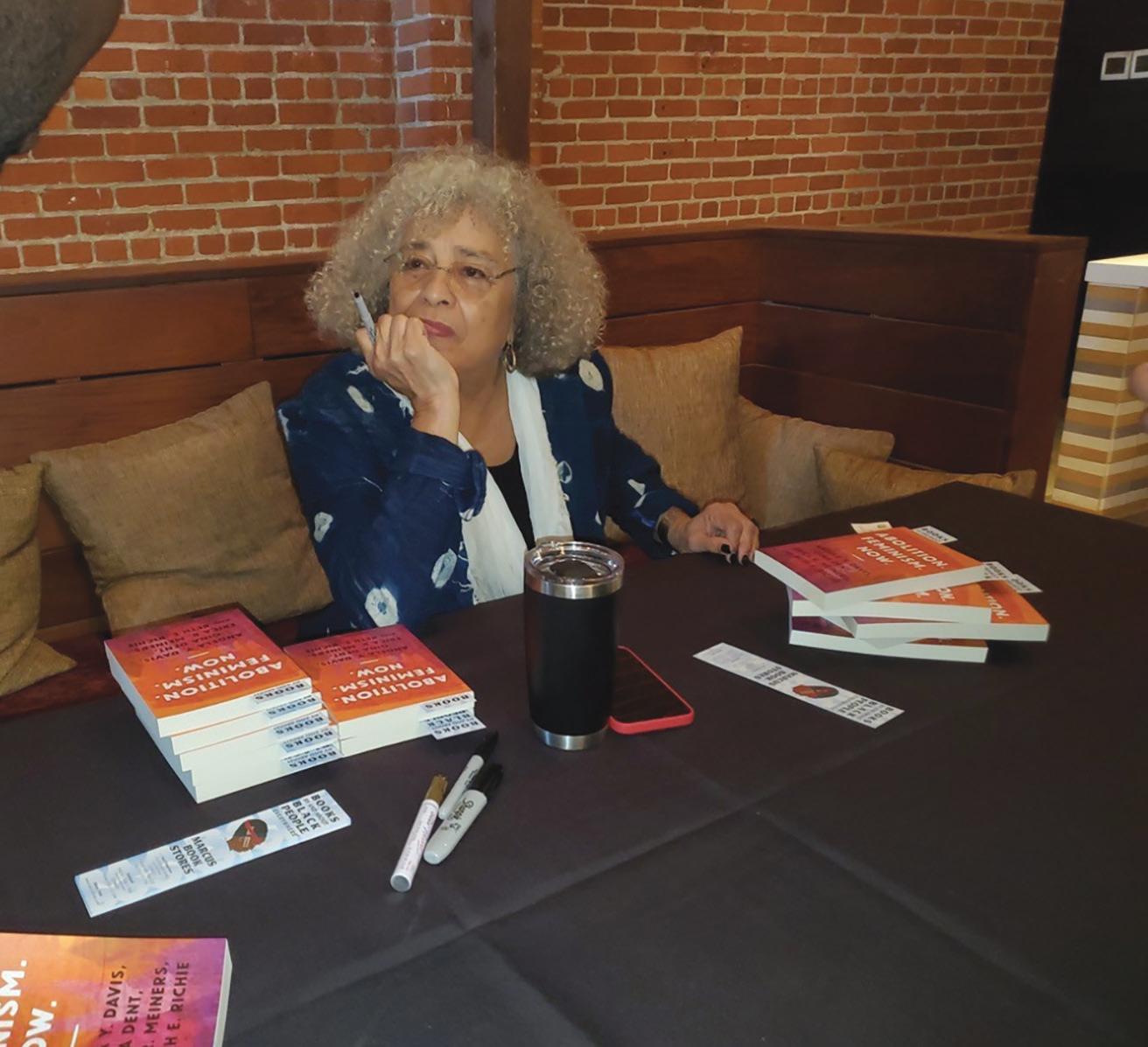
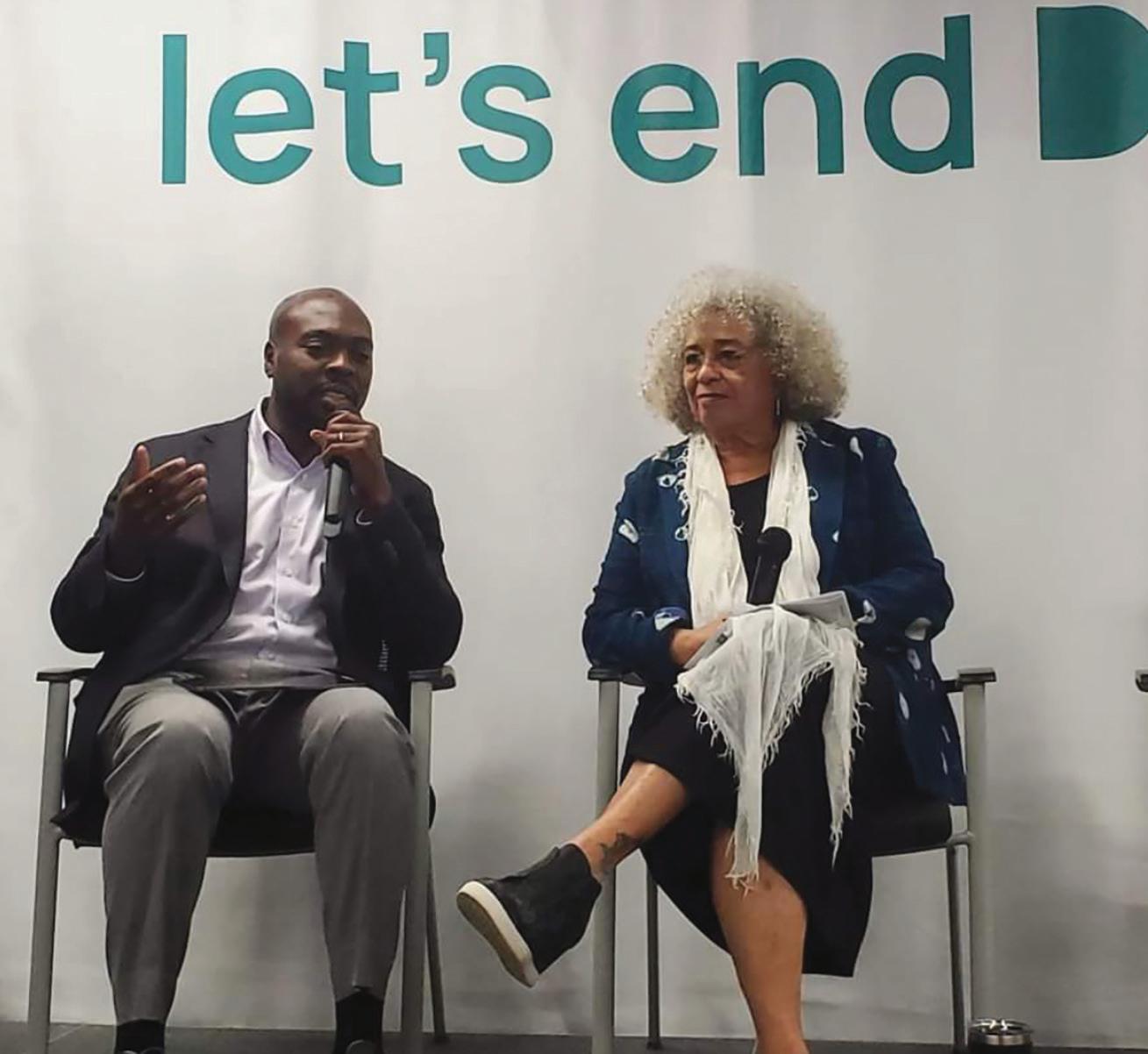
Angela Davis Shares Insights on Domestic Violence in Black Communities During Sacramento Panel
Antonio Ray Harvey
California Black Media
Philosopher, civil rights activist, college professor, author, and former political prisoner Angela Davis put a lens on the deep-rooted damage domestic violence sows in the Black community, pulling from research she conducted for her 1999 book, “Blues Legacies and Black Feminism.”
The book examines the careers of influential Black women blues singers Gertrude “Ma” Rainey, Bessie Smith, Ida Cox, Rosa Henderson, and Billie Holiday in historical, social, and political contexts.
“I noticed that many of them sang about violence,” Davis said. “They sang about what was happening in their relationships.”
On Oct. 30, Davis shared her perspective on domestic violence as part of a conversation that addressed the disproportionate impacts Domestic Violence has on Black women and families. The event, hosted by Blue Shield of California Foundation (BSCF) and the California Black Freedom Fund (CBFF), was held in Sacramento.
CBFF is a five-year, $100 million initiative focused on Black power-building and ensuring movement-based organizations have the sustained investments they need to challenge systemic and institutional racism. Davis joined representatives of other organizations to discuss policies needed to end intimate partner violence. The gathering, mostly journalists, was a recording session at the offices of the news publication CalMatters and part of BSCF’s podcast series for Domestic Violence Awareness Month. Participants included Karen Earl, CEO of the Jenesse
Center; Trina Greene, founder and Executive Director of Parenting for Liberation; Kelli Dillon, from the City of Oakland Department of Violence Prevention; and Eric Morrison-Smith, Executive Director of the Alliance for Boys and Men of Color.
Debbie Chang, President and CEO of BSCF, and BFF Executive Director Marc Philpart facilitated the activities, while journalist Bonnie Boswell moderated the roundtable discussions among Earl, Green, Dillon, and MorrisonSmith.
“We really needed to have this session focus on the disproportionate impact of domestic violence especially on California’s Black community,” Chang told California Black Media. “We’re shining a light on it and bringing attention to it. We can’t be silent about it. What we want are solutions.”
Davis, who will turn 80 on Jan. 26, is best known as a champion became of prison reform, women’s rights, racial equality, and the inequality of capitalism. An advocate for the LGBTQ community, Davis was once an active member of the Communist Party USA and the Black Panther Party for Self Defense.
Today, she is the Distinguished Professor Emerita of the History of Consciousness at the University of California at Santa Cruz. She first became aware of domestic violence as a “political issue” in the 1970s, she said. Davis stated that intimate violence not only affects women but men, children, and families.
“We’re talking about a form of violence that has been
in most human societies for hundreds of years. We also learned how to hide it, and then, somehow, it’s represented as just the problem of the survivor,” Davis said. “It’s always been considered a women’s issue.”
Davis pointed out that she wanted everyone to understand that domestic violence didn’t emerge during the feminist movement of the 1960s and 1970s.
“We periodized that movement as happening in the ’60s when women, largely White, began (speaking out against violence against women),” Davis said. “I wanted us to have a sense of how long it often takes for these ideas to make a difference.”
With support from BSCF, Social Action Partners (SoACT) developed a mixed-methods study of perceptions and attitudes surrounding domestic violence in California’s Black/African American community.
The report, 2017 Black Leaders Survey on Domestic Violence, provides the BSCF domestic violence advocates and community stakeholders’ insights on how Black communities in California perceive the challenges they face in combating domestic violence.
According to the National Intimate Partner and Sexual Violence Survey, 34%, or one in three California women report experiencing domestic violence at some point in their lifetimes. The BSCF report states that 42.5% of Black women report experiencing intimate partner violence, compared to 39.3% of White women and 30.2% of Hispanic women.
On March 8, the Los Angeles City Council received an Equity Analysis on the Violence and Crime that Black
women and girls experience from the Civil, Human Rights, and Equity Department (LA Civil Rights). Overall, violent crime rates have decreased in Los Angeles over a 10-year period but the number of Black women experiencing violence has increased. Black women comprise approximately 4.3% of Los Angeles’ population but they often make up approximately 25% to 33% of victims of violence, the report stated.
The San Francisco Family Violence Council’s 2020 report also revealed racial disparities among domestic violence survivors. It states that 28% of dependent adult abuse victims were Black; and more than half of domestic violence victims were Black or Latino.^pFor Philpart, the drive to prevent domestic violence is personal. His grandmother was killed by her husband in 1965 after she divorced him and remarried.
“It’s important for us to have this conversation about the Black community because we often don’t talk about domestic violence,” Philpart said. “As the panelist said, we keep DV as something that is unspoken of or is part of our family history that’s never unearthed. Philpart’s family tragedy highlights another statistic. According to the Center for Relationship Abuse Awareness, 75% of homicides related to domestic violence occur after intimate partners’ separation. “We are gathered here today discussing an issue that first became a part of discourse over 50 years ago. As a matter of fact, this is the most widespread, pandemic form of violence in the world,” Davis said.
A Festival of Lights: Celebrating Diwali in California
Edward Henderson California Black MediaDiwali is one of the major Asian Indian religious festivals observed in Hinduism, Sikhism and Jainism. It celebrates the victory of light over darkness, good over evil, and knowledge over ignorance.
Known as “The Festival of Lights’ it is celebrated globally across diverse religions and cultures. This year, Diwali will fall on Nov. 12, and for most who observe it, celebrations will last five days. The date of the celebration changes every year because it is based on the Hindu lunar calendar.
The celebration of the holiday varies depending on regional customs and traditions. Among Hindus, the most widespread custom is the lighting of ‘diyas’, small lamps filled with oil, on the night of the new moon to invite the presence of Lakshimi, the goddess of wealth. In Northern India, the festival also celebrates the royal homecoming of Rama to the city of Ayodhya after defeating Ravana, the 10-headed king of the demons.
California native Happy Uppal spoke with California Black Media (CBM) and shared how her family celebrated Diwali when they lived in India and how it has changed for them since coming to the US.
“Speaking to my family about the holiday, Diwali meant we were going to have a lot of food, go to festival shows, and do fireworks. We used to light candles around our entire house. It was something my family looked forward to every year in India because they celebrated a lot. The holiday meant that they got to be with family and celebrate our culture at the same time. It was a time of new beginnings and cleansing of the past,” said Uppal.
With around 902,621 people who identify as Asian Indian, California has the largest population of Sikhs, Hindus and Jains in the United States.
Traditionally, the first day of Diwali, known as Dhanteras, is dedicated to cleaning homes and purchasing small items of gold. Lakshimi is the focus of worship on this day. The second day, called Naraka Chatrudashi or Choti Diwali, prayers are offered for the souls of ancestors. On the third day, Lakshimi Puja, families seek blessings from Lakshimi to ensure their prosperity, light candles,
fireworks, and visit temples. On the fourth day, known as Goverdhan Puja, merchants perform religious ceremonies and open new account books. The final day called Bhai Dooj, celebrates the bond between brothers and sisters.
To the Jains, the holiday has a different meaning.
For them, Diwali is the day when the last of the Jain Tirthankaras, Lord Mahavira, attained nirvana, a spiritual state characterized by the transcendence of mortal limitations and obstacles, and the attainment of infinite knowledge and enlightenment. Lord Mahavira established the dharma followed by the Jains worldwide.
For the Sikhs, Diwali is a story of the struggle for
freedom. It celebrates the victory of the sixth guru, Guru Hargobind, from the designs of Emperor Jahangir, who had imprisoned him and 52 other princes with him, in 1619. Guru Hargobind refused to leave the prison for freedom until he was able to bring all of the princes with him.
“The celebration is minimal in the United States unless you go to a temple,” said Uppal. “Not as many families celebrate as much as homes in India. Celebrations usually still include some sort of special sweet dish and lighting of a few candles.”

The BAPS Swaminarayan Sanstha (BAPS) in Southern California hosts one the most elaborate Diwali celebrations. This spiritual, volunteer-driven organization is dedicated to improving society through individual growth by promoting Hindu values of faith, unity and selfless service.
Along with the sweets, Samosas are very popular dishes to enjoy during Diwali celebrations. Aloo Bonda, a potato stuffing inside of a crispy coating of gram flour is another favorite amongst observers.
The center sits on 20 acres and includes 164,000 square feet of building space. On Diwali, the building is illuminated with multi-colored light shows, fireworks, lamps music and festive energy. Their Diwali celebration will take place on Nov. 10-13. The “Diwali Light and Sound Spectacular” takes place on the Nov. 11, 12, and 13, from 6-8 p.m. -with shows every thirty minutes.
During a time in the world where the darkness seems to be more prevalent daily, taking the time to acknowledge the beauty and hope light brings is what Diwali is all about,” Uppal said. Here are additional Diwali celebrations to look out for if you are interested in experiencing the festival of renewal and light.
Diwali at the Pomeroy Center Saturday, Nov. 18 from 3-7pm 207 Skyline Boulevard San Francisco, CA 94132
The event includes arts and crafts for children under 12, professional Indian Dance Performances and a buffet dinner with ticket purchase.
Diwali Fest 2023 – Festival of Lights Sunday, Nov. 12, 2023, from 7 p.m. to 9:30 p.m. Art of Living Dome 948 West Adams Boulevard, Los Angeles, United States This event will have all the aspects of celebration which include lighting Lamps (diyas/tealight candles provided), an opportunity to make a personal Sankalpa (deep wish) and offering. Lighting lamps and Dance performances, meditation and Indian cuisine.
All are welcome and anyone who comes for the event can witness a traditional Hindu ritual called the puja. This California Black Media report was
by
‘Worse Than People Can Imagine’: Medicaid ‘Unwinding’ Breeds Chaos in States
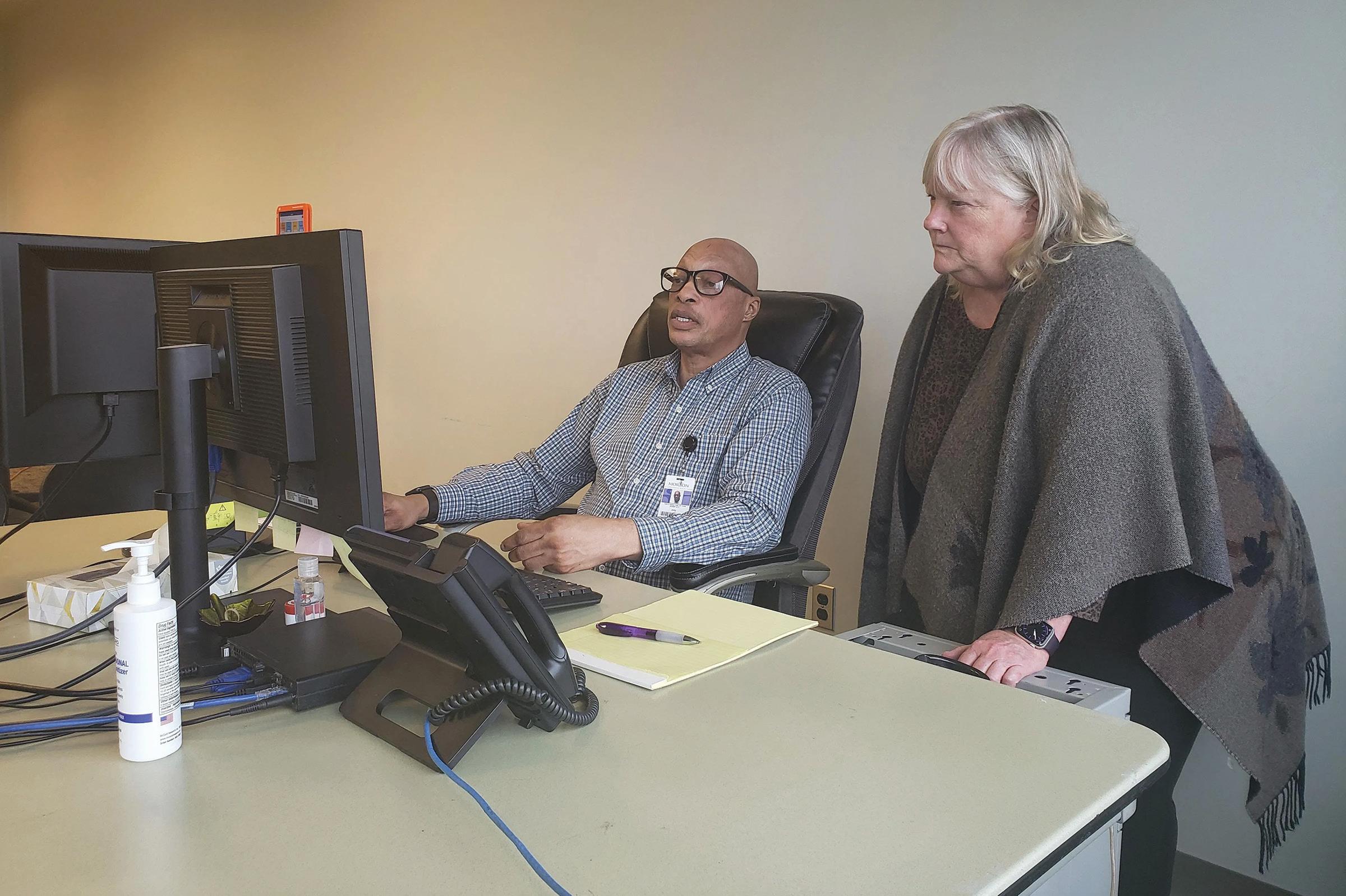
On May 4, 2023, Jody White (left) and Grace Burke of Morton Comprehensive
Tulsa, Oklahoma, examined a list of the health center’s patients whose Medicaid eligibility was up for review that month. White had spent the morning calling patients on the list to make sure they were aware of the process and offer his assistance.(Bram
By Phil Galewitz and Katheryn Houghton and Samantha Liss and Bernard J. WolfsonIn California, staffing shortages at county agencies that administer Medi-Cal, the state’s Medicaid program, are making it more difficult for people to renew their coverage.
In Missouri and Florida, callers waited on hold for more than two hours on hotlines to renew their Medicaid coverage.
In Tennessee, the parents of a disabled man who had been on Medicaid for three decades fought with the state this summer to keep him enrolled as he lay dying from pneumonia in a hospital.
Seven months into what was predicted to be the biggest upheaval in the 58-year history of the government health insurance program for people with low incomes and disabilities, states have reviewed the eligibility of more than 28 million people and terminated coverage for over 10 million of them. Millions more are expected to lose Medicaid in the coming months.
The unprecedented enrollment drop comes after federal protections ended this spring that had prohibited states from removing people from Medicaid during the three pandemic years. Since March 2020, enrollment in Medicaid and the related Children’s Health Insurance Program had surged by more than 22 million to reach 94 million people.
The process of reviewing all recipients’ eligibility has been anything but smooth for many Medicaid enrollees. Some are losing coverage without understanding why. Some are struggling to prove they’re still eligible. Recipients and patient advocates say Medicaid officials sent mandatory renewal forms to outdated addresses, miscalculated income levels, and offered clumsy translations of the documents. Attempting to process the cases of tens of millions of people at the same time also has exacerbated long-standing weaknesses in the bureaucratic system. Some suspect particular states have used the confusing system to discourage enrollment.
“It’s not just bad, but worse than people can imagine,” said Camille Richoux, health policy director for the nonprofit Arkansas Advocates for Children and Families. “This unwinding has not been about determining who is eligible by all possible means, but how we can kick people off by all possible means.”
To be sure, some of the Medicaid recipients who signed on to the program when the U.S. unemployment rate soared amid covid-19 lockdowns have since gotten health insurance through new jobs as unemployment dropped back to pre-pandemic lows.
And some of the disenrolled are signing up for Affordable Care Act marketplace plans. Centene CEO Sarah London, for example, told investors on Oct. 24 that the health care giant expected as many as 2.4 million of its 15 million Medicaid managed care members to lose coverage from the unwinding, but more than 1 million customers had joined its exchange plans since the same time last year. Still, it’s anyone’s guess how many former Medicaid beneficiaries remain uninsured. States don’t track what happens to everyone after they’re disenrolled. And the final tallies likely won’t be known until 2025, after the
unwinding finishes by next summer and federal officials survey Americans’ insurance status.
Without Medicaid, Patients Miss Appointments
Trish Chastain, 35, of Springfield, Missouri, said her Medicaid coverage is scheduled to expire at the end of the year. Though her children are still covered, she no longer qualifies because her $22-an-hour income is too high. Chastain’s employer, a rehab center, offers health insurance, but her share of the premium would be $260 a month. “I can’t afford that with my monthly budget,” Chastain said.
Gaps in coverage can jeopardize people’s access to health services or their financial security if they get medical bills for care they cannot postpone.
Doctors and representatives of community health centers around the country said they have seen an uptick in cancellations and no-shows among patients without coverage — including children. Nationwide, states have already disenrolled at least 1.8 million children in the 20 states that provide the data by age. Children typically qualify more easily than adults, so child advocates believe many kids are being wrongly terminated based on their parents’ being deemed no longer eligible. Meanwhile, enrollment in CHIP, which has higher income eligibility levels than Medicaid, has shown only a tiny increase.
Kids accounted for varying shares of those disenrolled in each state, ranging from 68% in Texas to 16% in Massachusetts, according to KFF. In September, President Joe Biden’s administration said most states were conducting eligibility checks incorrectly and inappropriately disenrolling eligible children or household members. It ordered states to reinstate coverage for some 500,000 people.
Varying Timetables, Varying Rates of Disenrollment
Idaho, one of a few states that completed the unwind in six months, said it disenrolled 121,000 of the 153,000 recipients it reviewed as of September because it suspected they were no longer eligible following the end of the public health emergency. Of those kicked off, about 13,600 signed up for private coverage on the state’s ACA marketplace, said Pat Kelly, executive director of Your Health Idaho, the state’s exchange. State officials said they don’t know what happened to the rest.
California, by contrast, started terminating recipients only this summer and is automatically transferring coverage from Medi-Cal to marketplace plans for those eligible. Medi-Cal, by far the nation’s largest Medicaid program, with over 15 million enrollees, has cut just over 500,000 people in the first three months, according to the most current data available.
The Medicaid disenrollment rates of people reviewed so far vary dramatically by state, largely along a blue-red political divide, from a low of 10% in Illinois to a high of 65% in Texas.
“I feel like Illinois is doing everything in their power to ensure that as few people lose coverage as possible,” said Paula Campbell of the Illinois Primary Health Care Association, which represents dozens of community health centers.
Nationwide, about 71% of Medicaid enrollees terminated during the unwinding have been cut because of procedural issues, such as not responding to requests
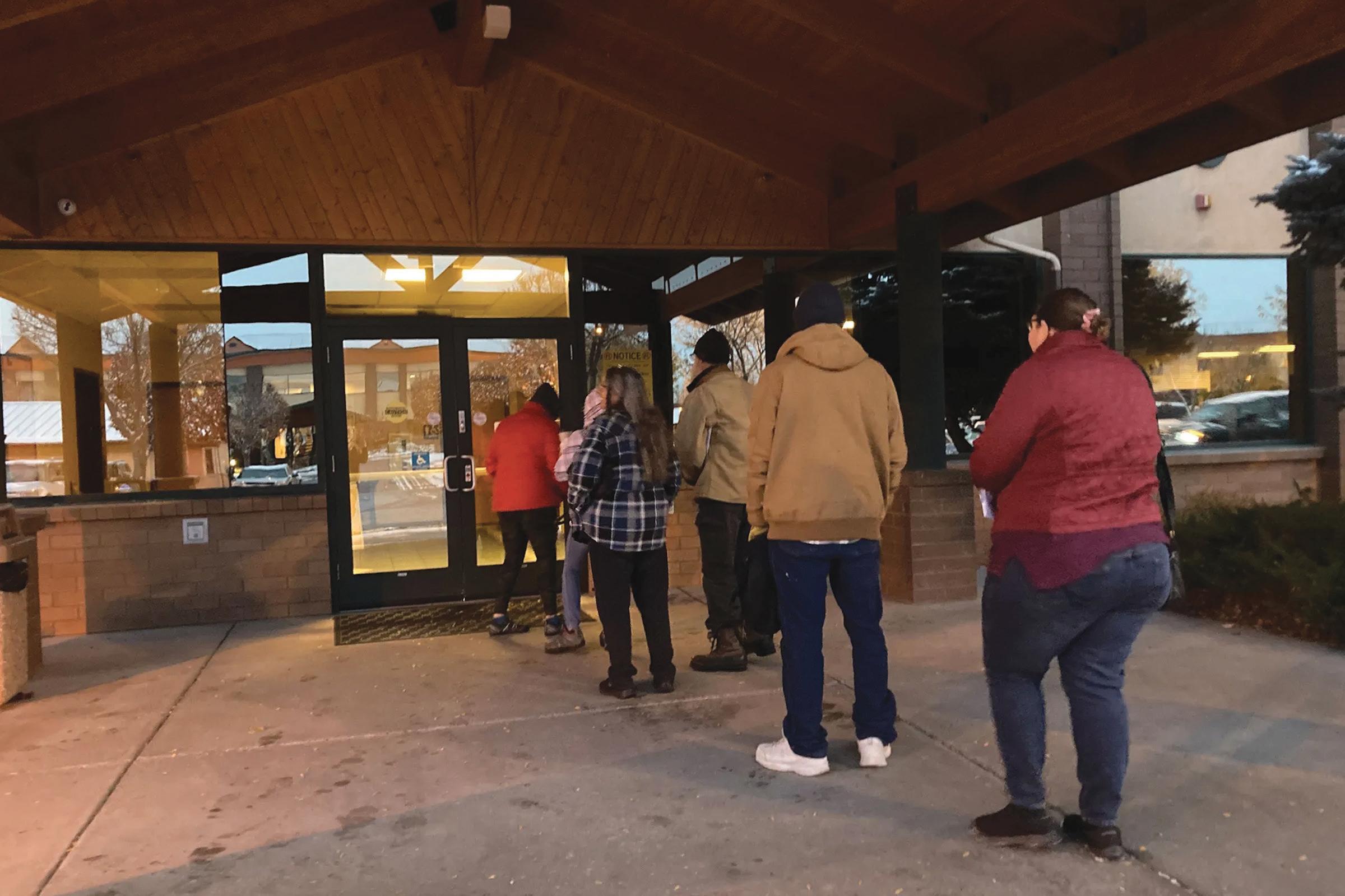
for information to verify their eligibility. It’s unclear how many are actually still eligible. In California, that number is 88%, the fifth highest among states, according to data tracked by KFF.
“It’s terrible. Eighty-seven percent of people with Medi-Cal don’t get to keep their coverage based on whether they actually qualify,” said David Kane, an attorney at the Western Center on Law and Poverty. “Instead, they see their health coverage cut off automatically for procedural and paperwork reasons largely outside of their control.”
But Yingjia Huang, assistant deputy director of health care benefits and eligibility at California’s Department of Health Care Services, which oversees Medi-Cal, said the main reason for paperwork-related terminations is that people don’t return their packets, which was a problem even before the pandemic. “Now, I think there is a group of people who most likely have obtained other forms of health insurance,” Huang said. “That’s probably one of the biggest reasons they don’t return their packets.”
State and local Medicaid officials across the country say they have tried contacting enrollees in multiple ways — including through letters, phone calls, emails, and texts — to check their eligibility. Yet some Medicaid recipients lack consistent addresses or internet service, do not speak English, or are juggling more pressing needs.
In California, officials acknowledge that staffing shortages are a problem but say they are working hard to fix it. Eileen Cubanski, interim executive director of the County Welfare Directors Association of California, said the counties are “hiring as fast as they can, and they are all training as fast as they can.”
‘People Are Not Getting Through’
In many states, enrollees have faced long waits to get help with renewals. The longest phone waits were in Missouri, according to a KFF Health News review of letters the Centers for Medicare & Medicaid Services sent to states in August. In the letter to Missouri’s Medicaid program, CMS said it was concerned that the average wait time of 48 minutes and the 44% rate of Missourians abandoning those calls in May was “impeding equitable access” to assistance and patients’ ability to maintain coverage.
In Florida, which has removed over 730,000 people from the program since April, enrollees earlier this year were waiting almost 2½ hours on a Spanish-language call center, according to a report from UnidosUS, a civil rights advocacy group. “They can barely get the Spanish translations right” on the Medicaid application, on the renewal website, and in other communications, said Jared Nordlund, the Florida director for UnidosUS.
Miguel Nevarez, press secretary for Florida’s Department of Children and Families, which is managing the state’s Medicaid redetermination process, criticized complaints about poor translations and long waits for the Spanish-language call center as a “false narrative.” He said, “The data clearly shows Florida has executed a fair and effective plan for redeterminations.”
In California, similarly jammed phone lines, crowded and understaffed county offices, and trouble downloading renewal applications electronically are all “compounding people’s difficulty to renew” their Medicaid, said Skyler Rosellini, a senior attorney in the Los Angeles office of the
National Health Law Program. “We do know, based on the cases we’re getting, that people are not getting through.”
Jasmine McClain, a 31-year-old medical assistant, said she tried everything before Montana ended Medicaid coverage for her kids, ages 3 and 5, in early October. She tried submitting paperwork online and over fax to prove they still qualified. She spent hours on hold with the state hotline. After her kids’ coverage ended, she went to a state public assistance office in Missoula but couldn’t get an appointment. One day in mid-October, roughly 30 people lined up outside the office starting as early as 6:40 a.m., before its doors opened.
After three weeks of her pleading for help while her kids were uninsured, the state restored her kids’ coverage. A supervisor told her the family’s paperwork submitted online had not been processed initially.
Spokespeople for the Montana, Florida, and Missouri Medicaid programs all said their states had reduced call wait times.
Some Medicaid recipients are seeking help through the courts. In a 2020 class-action lawsuit against Tennessee that seeks to pause the Medicaid eligibility review, parents of recipients describe spending hours on the phone or online with the state Medicaid program, trying to ensure their children’s insurance coverage is not lost.
One of those parents, Donna Guyton, said in a court filing that Tennessee’s Medicaid program, called TennCare, sent a June letter revoking the coverage of her 37-year-old son, Patrick, who had been eligible for Medicaid because of disabilities since he was 6. As Guyton made calls and filed appeals to protect her son’s insurance, he was hospitalized with pneumonia, then spent weeks there before dying in late July.
“While Patrick was fighting for his life, TennCare was threatening to take away his health insurance coverage and the services he relied on,” she said in a court filing. “Though we should have been able to focus on Patrick’s care, our family was required to navigate a system that kept denying his eligibility and putting his health coverage at risk.” TennCare said in a court filing Patrick Guyton’s Medicaid coverage was never actually revoked — the termination letter was sent to his family because of an “error.” Phil Galewitz in Washington, D.C., wrote this article. Daniel Chang in Hollywood, Florida; Katheryn Houghton in Missoula, Montana; Brett Kelman in Nashville, Tennessee; Samantha Liss and Bram Sable-Smith in St. Louis; and Bernard J. Wolfson in Los Angeles contributed to this report.
This article was produced by KFF Health News, formerly known as Kaiser Health News (KHN), a national newsroom that produces in-depth journalism about health issues and is one of the core operating programs at KFF — the independent source for health policy research, polling, and journalism. KFF Health News is a national newsroom that produces in-depth journalism about health issues and is one of the core operating programs at KFF—an independent source of health policy research, polling, and journalism. Learn more about KFF.
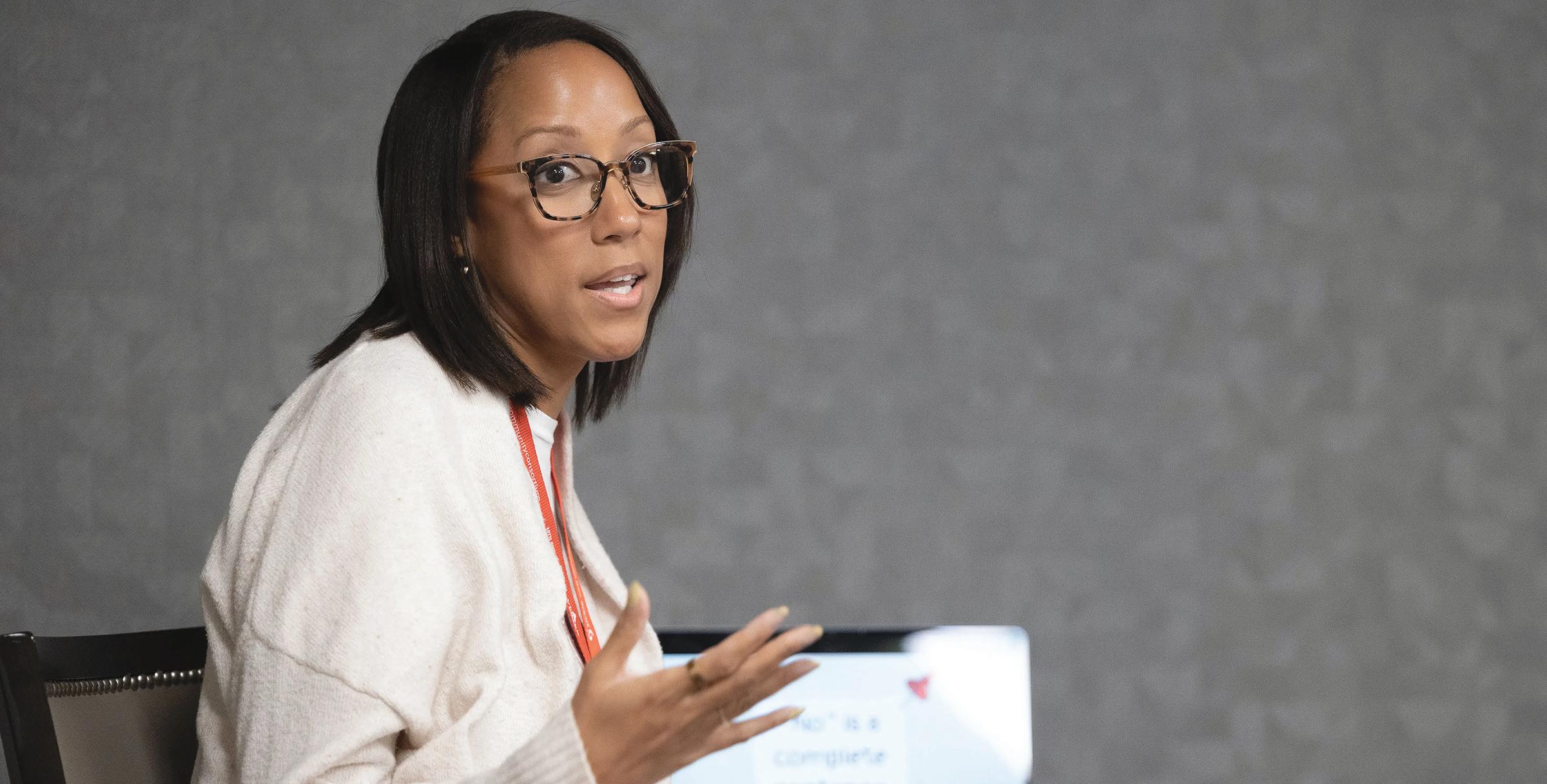
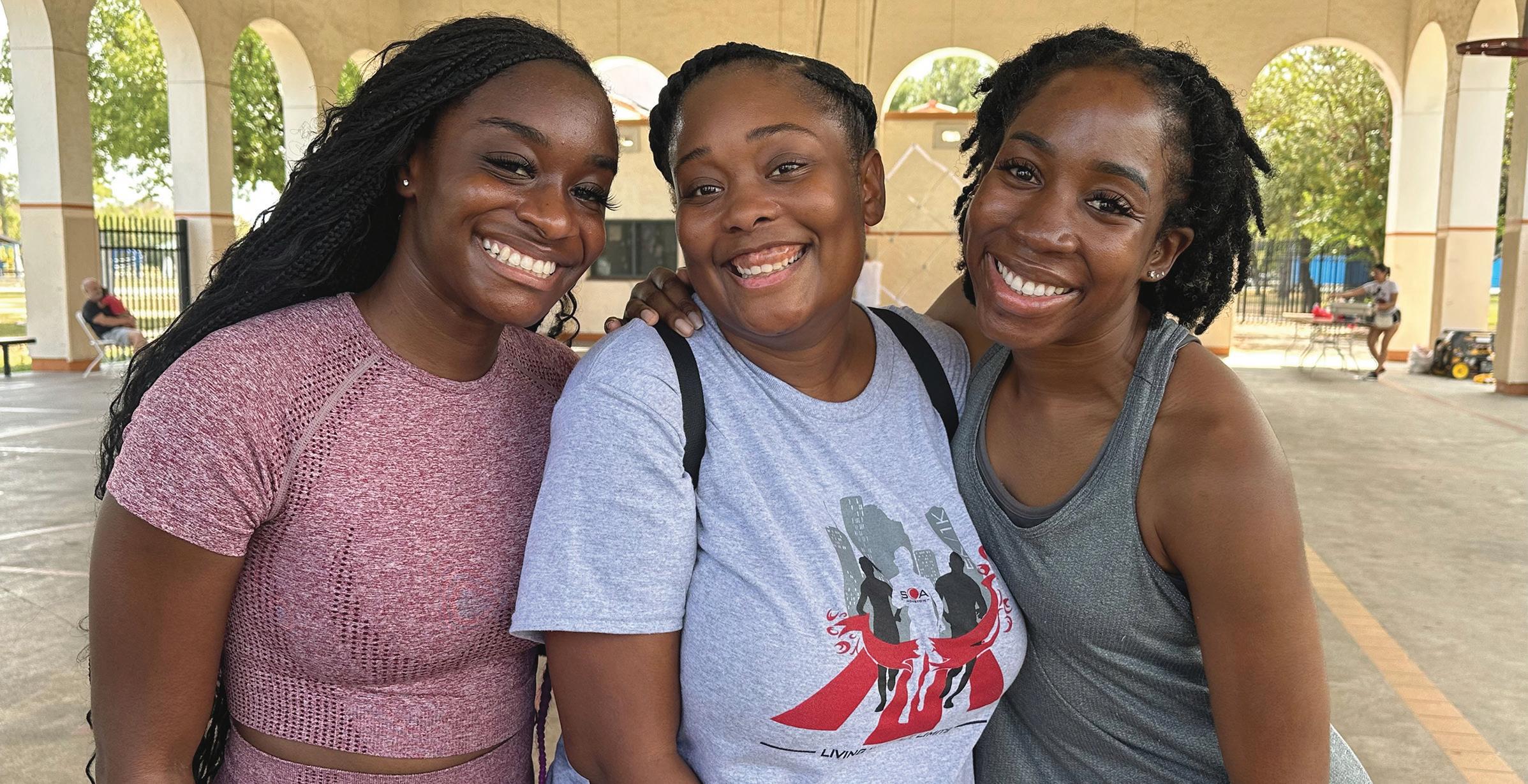
the disease, a sickle cell crisis can happen anytime and be excruciatingly painful, even life-threatening. Still, ER wait times are long and often frustrating. Patients like
must balance advocating for
during bouts of
against the
not to irritate or alienate hospital
For People With Sickle Cell Disease, ERs Can Mean Life-Threatening Waits
By Sara Hutchinson Heather Avantalways dresses up when she goes to the emergency room.
“I’ve been conditioned to act and behave in a very specific way,” said Avant. “I try to do my hair. I make sure I shower, have nice clothes. Sometimes I put on my University of Michigan shirt.”
It’s a strategy to combat discrimination the 42-yearold photographer in Mesquite, Texas, has developed over a lifetime of managing her sickle cell disease, a rare blood disorder that affects an estimated 100,000 Americans. The hereditary condition can affect a person of any race or ethnicity, but Black patients, like Avant, make up the majority of those afflicted in the U.S.
For people living with the disease, a sickle cell crisis can happen at any time. When it does, their rigid, sickleshaped red blood cells become stuck in their blood vessels, blocking flow and causing extreme pain or breathing difficulties. A crisis can escalate into life-threatening complications such as strokes, seizures, and sepsis.
When a pain crisis can’t be managed at home, patients head to the ER to get the high dosage of opioids they need, in addition to IVs to help with dehydration or even blood transfusions. Yet staffers in emergency departments — already overextended and grappling with nursing shortages — don’t always have experience in treating the rare disease. Doctors, amid a still-raging opioid crisis, remain resistant to prescribing the painkillers necessary to treat sickle cell crises. So, patients say, they face long delays before receiving essential care, plus discrimination and suspicion that they are seeking drugs to get high.
“I have to look like I’m not coming in here off the street looking for medication,” said Avant. “I have to put on an entire show to get you to believe that I need care.”
Years of research have documented the delays. A study published in 2013 found that patients seeking care from 2003 through 2008 at an ER for their sickle cell crises waited 50% longer than patients who arrived with broken
legs or arms. A study published in 2021 found that 50% of sickle cell patients reported having to wait at least two hours before their pain was treated, despite medical guidelines recommending such patients in crisis receive their first dose of pain medication no more than 60 minutes after arriving at the ER.
Medical associations such as the American Society of Hematology, the National Heart, Lung, and Blood Institute, and the Emergency Nurses Association have established guidelines for emergency department-based care of sickle cell pain. And, in 2021, the Emergency Department Sickle Cell Care Coalition, a national collaboration of hematologists, pharmacists, and nurses, helped launch a point-of-care tool to help medical professionals manage the disease in the ER.
But patients and sickle cell experts said those best practices haven’t been widely adopted. A 2020 survey of nearly 250 emergency medicine providers found that 75% of them were unaware of the NHLBI’s recommendations, first published in 2014, yet 98% felt confident in their ability to treat patients with sickle cell disease.
Still, ER horror stories abound among adults with sickle cell disease. For Lesly Chavez, 29, a Houston hairstylist, her worst experience occurred a few years ago. She said she spent four hours in a waiting room before getting seen.
“And when they finally got to me, they told me they could help with ‘my addiction,’ but they decided that there was nothing that they could do for me,” Chavez said.
“They just flat-out said no and sent me home while I was in crisis.” Chavez said she has since avoided that hospital even though it’s 10 minutes from her home. Now she drives to an ER 30 minutes away. Chavez, who is Hispanic, said she confronts “doubt everywhere I go” because sickle cell disease primarily affects Black Americans. (Those who are Hispanic can be of any race.)
Paula Tanabe, a professor of nursing at Duke University who has spent decades researching ways to improve care for sickle cell patients, said a confluence of factors adds to the racial bias patients may face.
“Emergency rooms are incredibly overcrowded, at rates that we have never seen before, and that’s for everyone,” said Tanabe.
Legislators are trying to help. A federal bill introduced in June would allocate $8.2 million annually for five years to a program that trains doctors on best practices for caring for sickle cell patients. Another, introduced this spring, would provide funding for community organizations working to spread awareness about the condition and give student loan relief to medical providers who commit to working on the disease. Some state legislatures have established sickle cell task forces to improve physician education and care coordination.
Advocates for sickle cell patients said investment in data collection to track the disease is also important. Although the Centers for Disease Control and Prevention estimates that some 100,000 Americans have it, the true number is unknown. That’s because no national system exists to collect data on sickle cell, unlike other conditions such as diabetes, cancer, and Alzheimer’s.
“I’m 32 and we’ve been saying it’s 100,000 my entire life,” said Quannecia McCruse, who co-founded the Sickle Cell Association of Houston. “I know there’s more. I know people are going uncounted.”
Eleven state-led data collection programs currently exist and, in February, the CDC opened a new grant application for additional states. Improved data would allow funding to be allocated toward the areas with the greatest need, sickle cell patient advocates said.
Texas had an opportunity to join those efforts. This spring, the state legislature passed a bill with broad bipartisan support to create a sickle cell patient registry, but Republican Gov. Greg Abbott vetoed it, saying it would compromise patient privacy.
“That was a bad excuse,” said McCruse. “We have a cancer registry already, and everyone’s information is
That registry would have gone a long way to help.”
While progress grinds slowly, patients like McCruse say they’re forced to balance advocating for themselves during bouts of excruciating pain against the need not to irritate or alienate hospital staffers.
“It feels like someone is taking a Taser and shocking the crap out of me. Or when it’s really bad, and it feels like shards of glass are just moving through my veins,” said the mother of two. “It’s very, very painful. And you’re telling somebody whose body is torturing them that it’s not that bad?”
Alexis Thompson, a hematologist who treats sickle cell patients at the Children’s Hospital of Philadelphia, said she works with her pediatric patients to develop self-advocacy skills. But sometimes that backfires.
“The great irony is patients who are well informed and capable of self-advocating are being accused of being manipulative, because they are capable of articulating very clearly what’s effective for them down to the name of the medication or the absolute dose,” Thompson said.
Sickle cell experts recommend that doctors adhere to a patient’s individual pain plan, if available. Thompson said those plans, which document patients’ diagnoses alongside a recommended medication and dosage, can be uploaded to online portals that patients can pull up on their cellphones when visiting an ER to verify what they need.
Patients such as Avant hope such steps can help decrease their ER waits while easing their anxiety about seeking emergency care.
“I don’t fear dying,” said Avant, “but I do fear dying in the hospital.”
KFF Health News is a national newsroom that produces in-depth journalism about health issues and is one of the core operating programs at KFF—an independent source of health policy research, polling, and journalism. Learn more about KFF.


Chargers Get Monday Night Win
By Earl Heath Contributing Sports WriterThe Los Angeles Charger put together a team effort against the New York Jets and came away with a 27-6 win on Monday Night Football.
The Chargers are now back to .500 after breezing to the win at MetLife Stadium. Austin Eckler did his thing rushing for two touchdowns. He has scored seven TD’s on five Monday night games. However the big story was Keenan Allen making history by reaching the 10,000 career receiving yards plateau. The veteran wide receiver reached the mark on a leaping catch in the fourth quarter. He finished the game with eight catches for 77 yards. Wilson had 263 yards passing and Breece Hill had 50 yards rushing but the Jets couldn’t make the most of their trips into LA territory. Herbert went for 136 yards on 16/30 passing on a night in which the Chargers gained just 191 yards. Los Angeles’ defense sacked Wilson eight times. Joey Bosa had 2.5 of the quarterback sacks while Khalil
Mack and Tuli Tuipulotu each had a pair. They kept the Jets out of the end zone in the last minute of the game.
“This is what you call a total team effort “ said Charger head coach Brandon Staley.
The defense also forced three Jet turnovers as they had their three-game winning streak snapped. All three lost balls were fumbles, including two from quarterback Zach Wilson who was filling in for the injured Aaron Rodgers.
Rodgers was seen walking into the stadium with no crutches, no brace and no limp and was slinging passes in the pregame. That’s about the only comforting sight the Jets fans saw after another lackluster performance on the offensive end. New York’s defense sacked Justin Herbert five times as its offense outperformed the Chargers, racking up 270 yards compared to Los Angeles’ 191. The special teams also helped the Chargers’ cause as rookie Derius Davis had an 87-yard punt return touchdown in the first quarter.
The Chargers will be home this week at So-Fi.

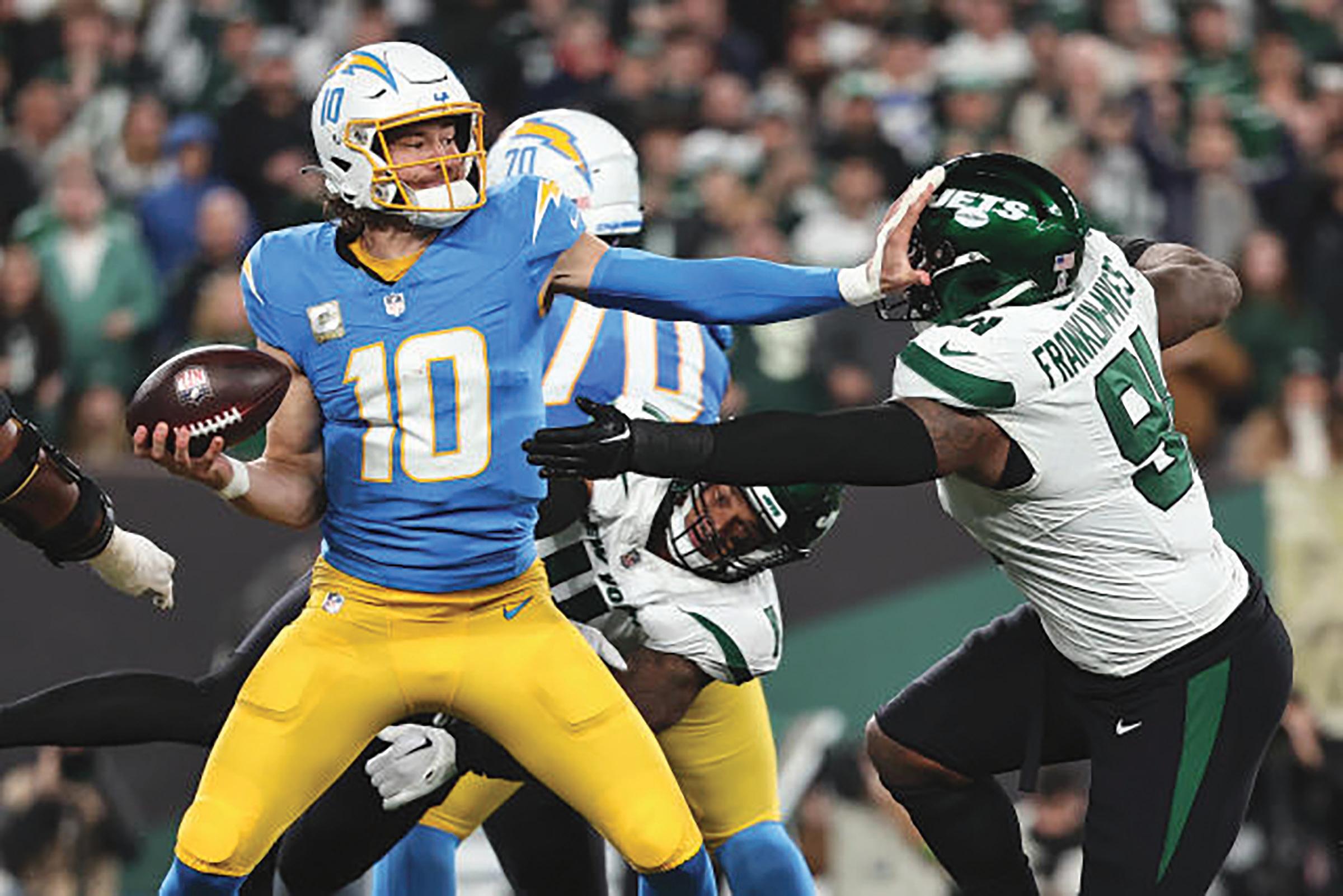

Walter Camp Names Trotter and Johnson Named Players of the Week

Rams turn things over against Packers
By Earl HeathIn Conversation with Doug E. Fresh NOLA MusiCon:
By Ricky Richardson Contributing Writer(New Orleans, LA) New Orleans is a city renowned for its vibrant musical heritage. The Crescent City hosted a new event to make its mark on the bustling cultural scene.
A jubilant and joyous crowd of 300 people were in attendance for the inaugural NOLA MusiCon, a music conference aimed at connecting industry professionals, musicians, students, and enthusiasts. The awesome event closed out October’s Music Month. NOLA MusiCon is a significant milestone for the burgeoning music scene in the heart of the Crescent City.
NOLA MusiCon was excited to be a part of the newly minted New Orleans Music Month, spearheaded by NOLA MusiCon Platinum Partner New Orleans & Company.
“Our mission for NOLA MusiCon is two-fold: to inform and educate artists and music industry professional, and to show that New Orleans not only has the best music in the world, but it is also a great place to grow your music
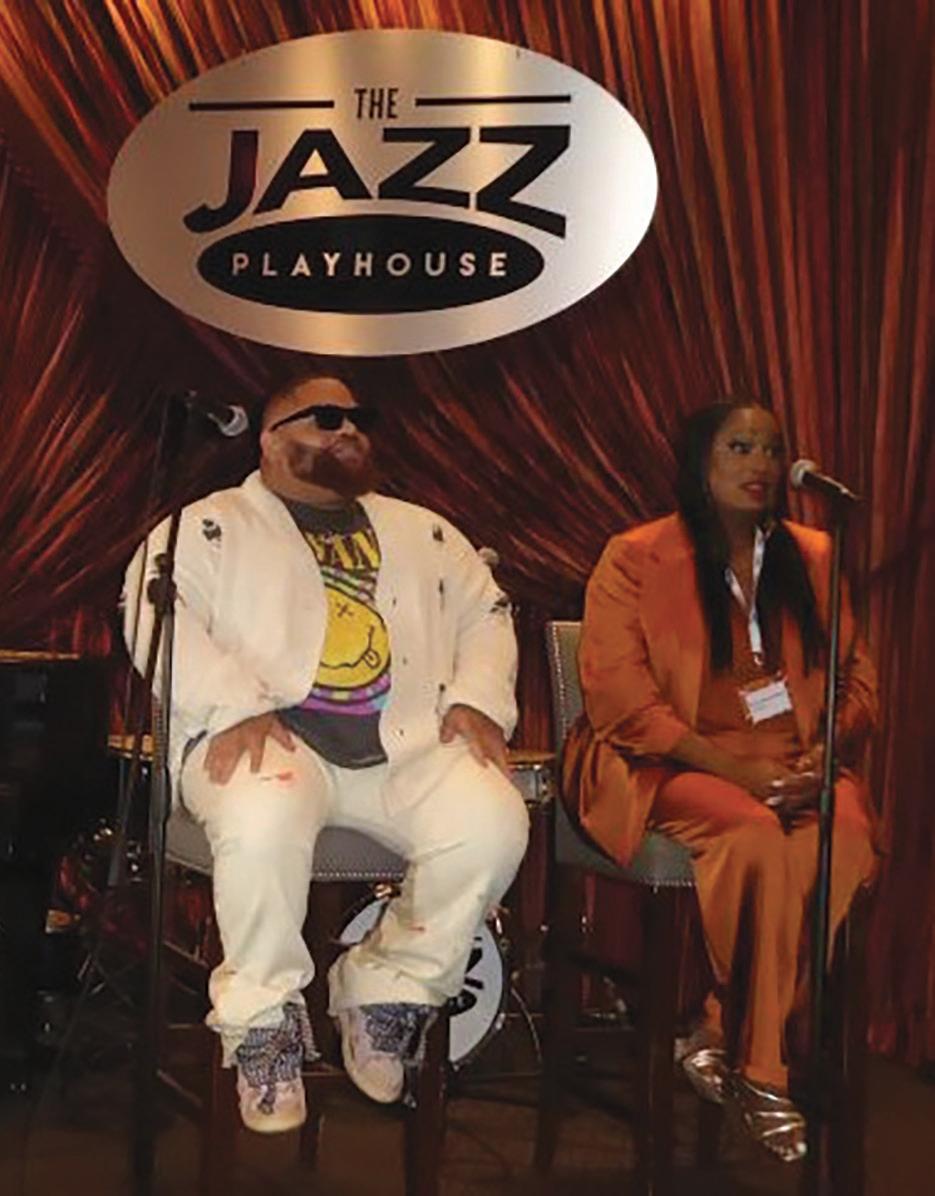
business.” Executive Producer, Melissa O’Brien. “This conference is a testament to the city’s cultural significance in the realm of music.
NOLA MusiCon is the next logical step in the evolution of NOLA Music Tech, which began as part of a larger group of events. NOLA Music Tech has expanded to encompass every aspect building a music/music career and has rebranded as NOLA MusiCon to reflect that expansion of ideas.
NOLA MusiCon featured four days of informative panels and inspirational interviews featuring music industry professionals and thought leaders, interactive hands-on demos of cutting-edge brands, one-on-one mentor sessions, in-dept. workshops, and live performances from emerging and established local talent, unparalleled networking and much more.
Attendees were able to immerse in topics from music creation, production, recording, and live performance to sync, music supervision, PR publishing, revenue streams, activism, preserving legacy and music tech. The inaugural event was held October 24-27, 2023, at the Royal Sonesta Hotel (300 Bourbon Street) in the heart of the French Quarter. NOLA MusiCon presented a positive ambiance for fostering collaboration and innovation.
Doug E. Fresh is a pioneering Hip-Hop artist who has been captivating audiences for nearly 40 years with his creation of the human beatbox art form. His unrivaled skill has resulted in an enduring legacy and continues to break new ground.
Doug E. Fresh sat down with Rosie Lopez, Co-founder and CEO of Opus Music Group to discuss his iconic career and what the future holds for this Hip-Hop legend.
Fresh shared that his first musical instrument was the trumpet, followed by how he started imitating various instruments and beat when the music program at his school was discontinued. A close friend called him the human beat box after hearing him drop beats with his voice. We all know that the rest is history. Doug E. Fresh gave an overview of Hip-Hop genre and mentioned his rise in the music industry along with other music icons, Slick Rick, Jay Z, Tupac and Biggie to name a few. Doug E. Fresh shared his take on AI. We should embrace artificial intelligence and used it in a productive manner.
Fresh shared that “your endurance is your insurance.”
He segued into the importance of taking care of one’s health. Fresh doesn’t drink alcohol or do drugs. He reiterated the importance drinking plenty of water to stay hydrated and healthy eating habits.
Doug E. Fresh is a tireless social activist and a vocal proponent of artists’ rights. Fresh currently serves as a Vice President and Co-founder of Hip-Hop Public Health, nonprofit whose mission is to end health illiteracy through

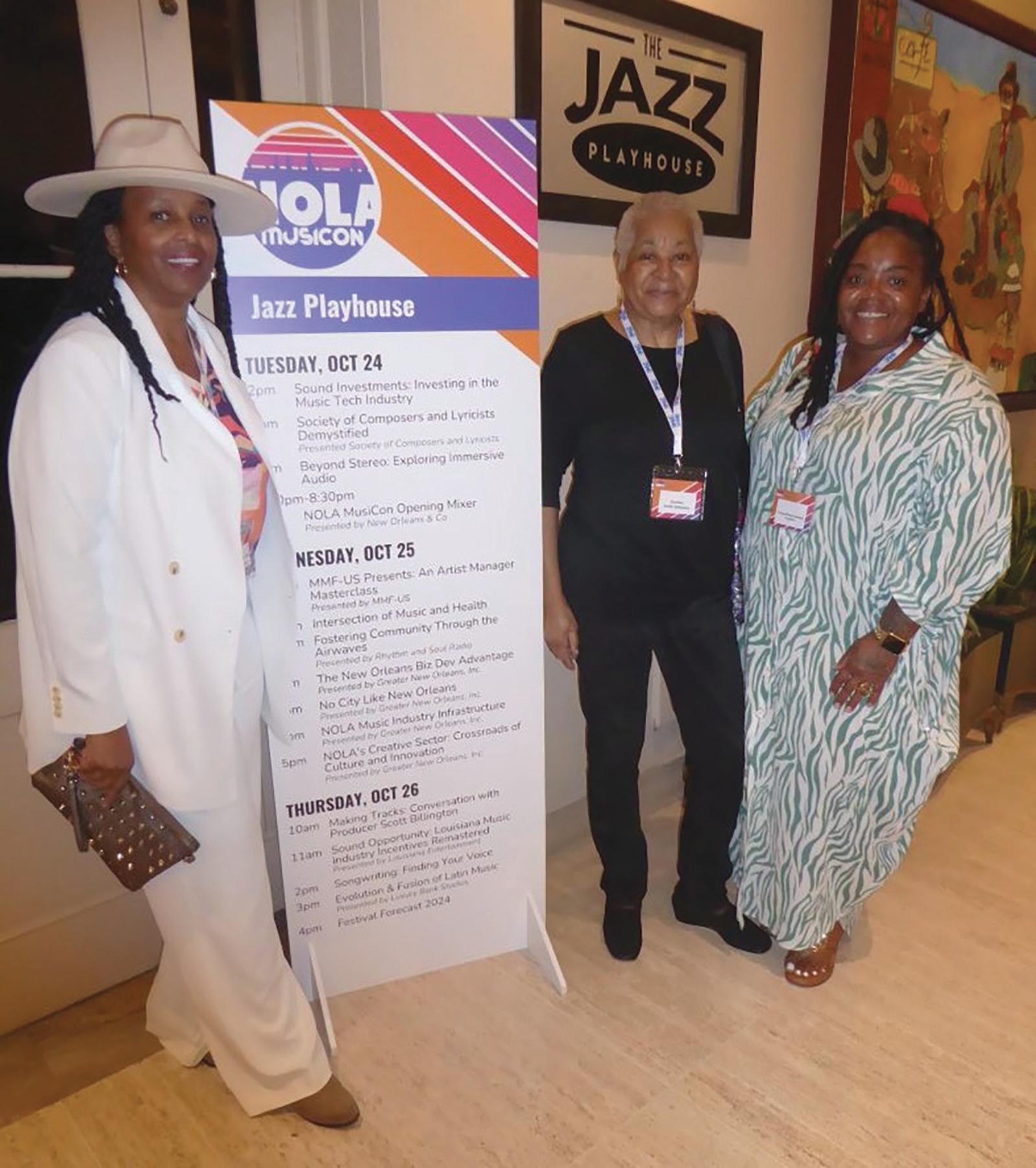
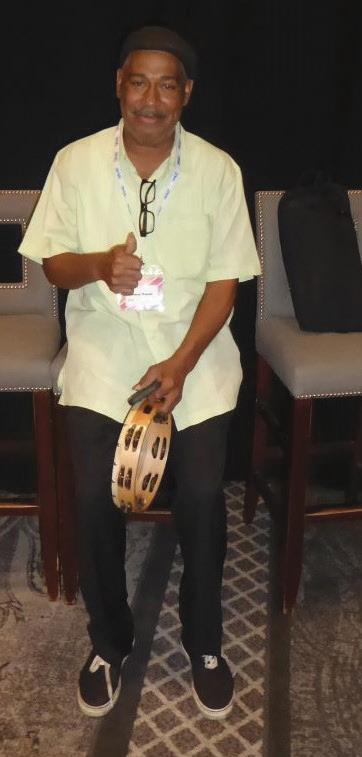
music and to foster positive health behavior changes, beginning with school-age children. Doug E. Fresh encouraged men in the audience to get a health check-up and actively with your medical team that can help one to catch early signs of diseases.
Doug E. Fresh also emphasizes the importance of Prostate screenings. On a related note, September was Prostate Cancer Awareness Month. U.S. Senators John Boozman (R-AR) and Cory Booker (D-NJ) introduced legislation to expand insurance coverage for prostate cancer screenings. The bipartisan Prostate- Specific Antigen (PSA) Screening for High-risk Insured Men (HIM) Act would require private health insurance plans to cover preventive prostate cancer screenings without imposing a cost sharing requirements for men who are at high risk of developing prostate cancer. Currently, the Prostate-Specific Antigen (PSA) test is the most effective tool for detection. When detected in stage 1, it’s almost 100 percent survivable.
Hotel guests and NOLA MusiCon attendees could feel the excitement and energy in the lobby and corridors of the Royal Sonesta Hotel.
I attended many sessions throughout NOLA Musicon. All of the sessions were engaging, educational as well as fascinating. The conference featured many sessions that
were inter-related and interconnected.
Session highlights featured Sound Investments: Investing in Music Tech Industry with Donovan Williams, Davorio Stevenson, Lisa LaCour and Greg Bresnitz; Songwriting Workshop with Vurdell “VScript” Muller and Robin Nicole Kindrick; The Historical Stages ProjectDiplomacy, digital Tourism & Cultural Preservation with Winston “Trombone” Tuner, Tonya Boyd-Cannon, Laila Bondi, Dwan Adams, Diedra (Deepa Soul) Meredith, Troy Sawyer, Dorathea Smith-Simmons and Nana Sula Spirit. Additional sessions were Crisis & Opportunity: The Evolution of The Music Format with Darren Hoffman and Shannon Powell; Publishing 101: What Can a Music Publisher Do for You? with Lamar Pickett, Vurdell “VScript” Muller, Timothy Burnett and Ryan Vaughn; The Intersection of Music & Health with Caitlin Sullivan, Catherine Lasperches, FNP, Dr. Ira “Ike” Padnos, and Dr. Lana Joseph-Ford; Fostering Community Through the Airwaves with Dave Ankers and Marko Nobles; The New Orleans Biz Dev Advantage with Josh Fleig and Louis David; the Power of Fans: Strategies for Fan Engagement with David Da Christofaro, Bryant Calhoun, Stacey Bedford and Charles Alexander; Behind the Boards with Darius “Deezle” Harrison, Emily Eck, Antonio K.C. Kearney and Rick Nelson. Visit NOLA MusiCon website for the complete scheduled of speakers and sessions. https:// nolamusicon.com/speakers and https://nolamusicon.com/ schedule I’m hopeful that you will share this valuable information with your network that is involved in any aspect of music and entertainment industry. Please visit https://nolamusicon.com to connect on all Social Media Platforms.
New Orleans and Company is the tourism and hospitality industry’s official destination sale marketing and trade organization, responsible for driving over $10 billions of diverse annual business to the regional cultural economy. We attract leisure and cultural travel, business meetings, conventions, weddings, festivals, sporting and special events to New Orleans in a highly competitive global environment. Founded in 1960, New Orleans & Company is committed to celebrating the richness of our culture while creating jobs, building careers and enhancing the quality of life for every New Orleanian.
